Aboriginal
Where Do Aboriginal Live in Australia
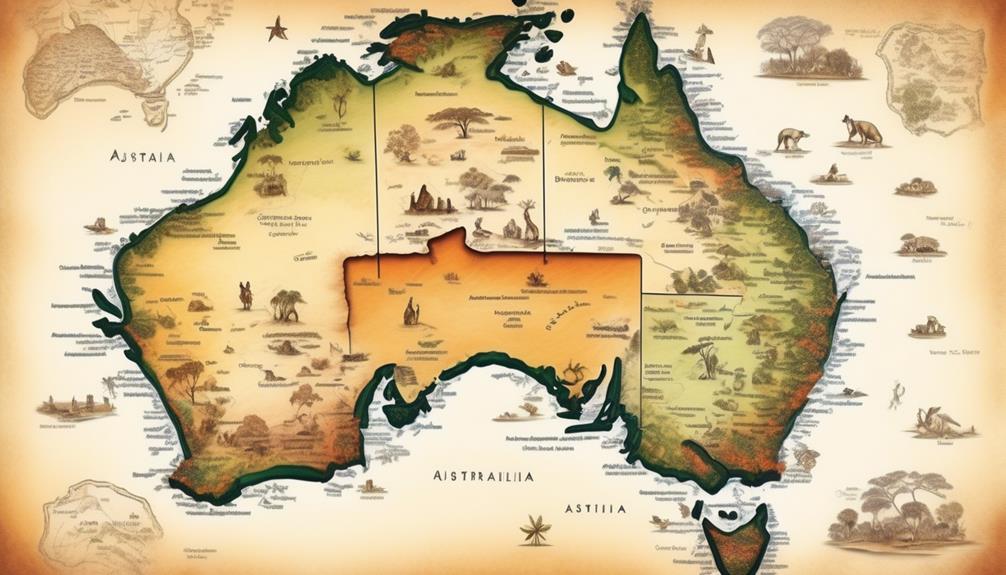
According to the latest census data, over 33% of Indigenous Australians live in major cities, showing a significant shift from their traditional rural and remote homes.
However, the distribution of Aboriginal people across the vast Australian landscape is far more complex than this statistic suggests. From the coastal regions to the outback settlements, Indigenous communities have unique living arrangements that reflect their cultural ties, historical connections, and contemporary challenges.
Understanding the diverse locations where Aboriginal people live in Australia provides a fascinating glimpse into their resilience and adaptation in the face of modern societal changes.
Key Takeaways
- Urban areas have a significant Aboriginal population, but they face challenges in accessing meaningful employment opportunities and quality education.
- Remote communities face unique challenges in accessing essential services and employment opportunities, but efforts towards sustainable economic development and local entrepreneurship are being made.
- Regional towns need to address issues of overcrowding and limited availability of suitable housing, while also considering traditional Aboriginal housing styles and communal living arrangements.
- Aboriginal communities in metropolitan cities reflect cultural integration, but still face socioeconomic challenges such as unemployment and inadequate access to education and healthcare. Grassroots initiatives and community engagement are important for addressing their diverse needs.
Urban Areas
In urban areas of Australia, Aboriginal communities are navigating a complex intersection of traditional cultural practices and modern urban living. The dynamics of urbanization have brought both challenges and opportunities for Aboriginal people.
One of the key challenges faced by Aboriginal communities in urban areas is accessing meaningful employment opportunities. Despite the growth of urban economies, Aboriginal Australians often encounter barriers to securing stable and well-paid jobs. This can be attributed to various factors including discrimination, lack of access to quality education, and cultural differences in the workplace. As a result, many Aboriginal individuals experience higher rates of unemployment and underemployment compared to the non-Indigenous population.
Moreover, urban education access remains a critical issue for Aboriginal communities. While urban areas may offer a wider range of educational institutions and resources, Aboriginal students often face systemic obstacles in accessing quality education. These barriers can manifest in the form of cultural insensitivity in educational curricula, a lack of support for Indigenous languages, and inadequate representation of Aboriginal history and knowledge. Additionally, socioeconomic disparities and limited access to educational support services contribute to lower educational attainment among Aboriginal students in urban areas.
In navigating these challenges, Aboriginal communities are actively seeking ways to promote greater inclusion in urban employment sectors and improve access to culturally responsive education. Initiatives aimed at fostering partnerships between Indigenous organizations and urban industries, as well as advocating for inclusive educational policies, are essential steps towards addressing these issues.
Remote Communities

Navigating the complexities of urban living has prompted Aboriginal communities to adapt to a contrasting way of life. This contrast is further exemplified in the unique challenges faced by Aboriginal people living in remote communities.
In these remote areas, community engagement and social infrastructure play crucial roles in maintaining the cultural fabric and well-being of the residents. The vast distances and isolation in remote communities create barriers to accessing essential services and opportunities. Despite these challenges, community engagement thrives through cultural practices and traditions, which foster a strong sense of belonging and collective identity.
Economic development and employment opportunities in remote communities are limited, often leading to financial hardship. The lack of industries and businesses means that many residents have to travel long distances for work, contributing to the economic strain and separation from their families and communities. However, initiatives focusing on sustainable economic development within these remote areas have shown promise. By supporting local entrepreneurship and traditional skills, there's potential to create employment opportunities that are closely tied to the cultural identity of the community.
The resilience and determination of Aboriginal people in remote communities are evident in their efforts to overcome these challenges. Despite the geographical barriers, there's a strong sense of unity and a deep connection to the land. It's essential to recognize and support the unique needs of these communities, ensuring that they have the resources and opportunities for sustainable development and prosperity.
Regional Towns
As we shift our focus to regional towns, it's important to consider the housing options available to Aboriginal communities, as well as the support services that are in place to ensure their well-being.
Additionally, our attention turns to the efforts being made to preserve the rich cultural heritage of Aboriginal people within these regional settings.
These aspects play a crucial role in understanding the experiences and challenges faced by Aboriginal individuals living in regional towns across Australia.
Aboriginal Housing Options
Amidst the vast expanse of regional towns in Australia, Aboriginal communities have a range of housing options that reflect their unique cultural and socio-economic circumstances.
In regional areas, many Aboriginal people live in government-provided housing or private rental properties. However, challenges persist, such as overcrowding due to limited availability of suitable housing and infrastructure. This situation is exacerbated by the migration of Aboriginal people from remote communities to regional towns in search of better opportunities.
The housing options in regional towns also face issues related to affordability and maintenance. Additionally, the cultural significance of housing is often overlooked, with traditional Aboriginal housing styles and communal living arrangements not being adequately considered in the current housing options.
Understanding and addressing these housing challenges in regional towns is crucial for ensuring that Aboriginal communities have access to safe, culturally appropriate, and affordable housing.
Community Support Services
In examining the provision of community support services in regional towns for Aboriginal communities, it becomes evident that a comprehensive understanding of their cultural and socio-economic needs is essential for effective and equitable assistance.
Community engagement and cultural support are crucial for developing services that respect and honor the traditions and values of Aboriginal peoples.
Health services play a significant role in addressing the specific health concerns and challenges faced by Aboriginal communities, while education opportunities are essential for empowering the younger generations and promoting long-term sustainability.
Cultural Preservation Efforts
Understanding the cultural and socio-economic needs of Aboriginal communities is integral to implementing effective cultural preservation efforts in regional towns. In regional areas, preservation initiatives play a crucial role in maintaining and celebrating traditional cultural practices. These efforts are vital for the continuation of Aboriginal heritage and knowledge, ensuring that future generations can access and honor their rich cultural traditions. Here's a snapshot of some of the cultural preservation initiatives in regional towns:
| Preservation Initiatives | Cultural Practices |
|---|---|
| Cultural festivals | Traditional dances |
| Indigenous language programs | Art and craft workshops |
| Land conservation projects | Storytelling sessions |
| Heritage centers and museums | Hunting and gathering demonstrations |
| Cultural exchange programs | Cultural knowledge sharing sessions |
These initiatives not only serve to preserve Aboriginal culture but also contribute to the cultural vibrancy and diversity of regional towns.
Coastal Regions
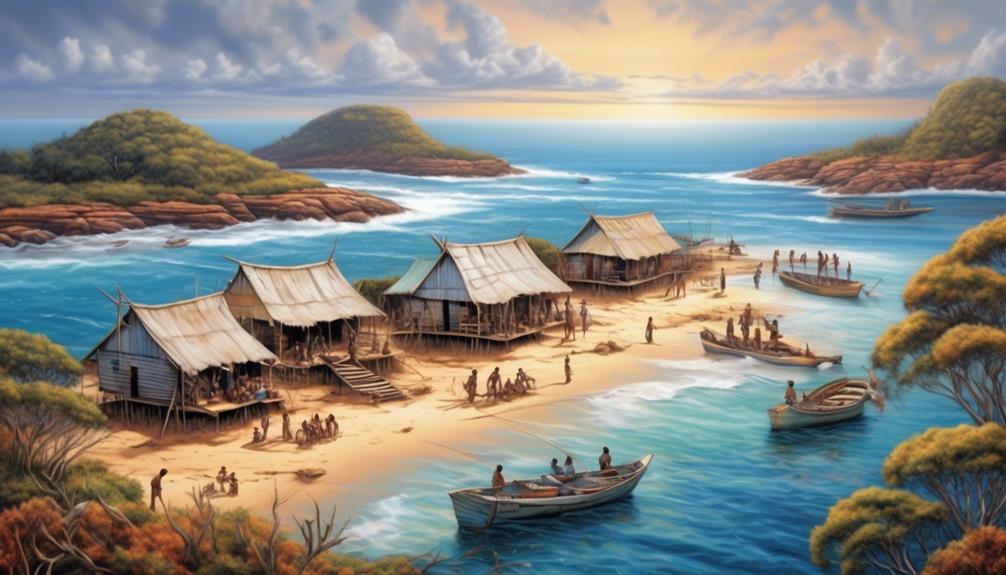
We have observed that many Aboriginal communities in coastal regions have a deep connection to the sea, which is reflected in their traditional fishing practices.
This connection extends beyond just sustenance, as the sea holds cultural significance and plays a vital role in spirituality for these communities.
Additionally, coastal regions provide abundant food sources such as shellfish and marine life, which have historically sustained Aboriginal populations.
Traditional Fishing Practices
Often practiced by Indigenous communities along the Australian coast, traditional fishing methods reflect a deep connection to the land and sea. The cultural significance of these techniques is profound, as they've been passed down through generations, preserving the knowledge and respect for the marine environment.
- Sustainable Practices: Indigenous fishing methods prioritize sustainability, ensuring that marine resources aren't overexploited.
- Community Bonding: Fishing activities foster a sense of community and shared responsibility, with knowledge and skills being shared among community members.
- Ceremonial Traditions: Fishing practices are often intertwined with ceremonial traditions, reinforcing cultural identity and spiritual connections to the sea.
The preservation of these traditional fishing practices not only sustains Indigenous communities but also offers valuable insights into sustainable living and environmental stewardship.
Connection to the Sea
In exploring the coastal regions, the enduring connection of Indigenous communities to the sea becomes strikingly evident through their traditional fishing practices, which embody a profound respect for the marine environment and sustainable living.
The traditional fishing practices of Aboriginal communities are deeply intertwined with their cultural and spiritual connection to the sea. Coastal food sources such as fish, shellfish, and marine plants have long been essential elements of the Aboriginal diet and are intricately linked to their traditional practices and knowledge systems.
These coastal communities have developed sustainable fishing methods that ensure the preservation of marine resources for future generations. The sea isn't just a source of sustenance; it holds deep cultural significance, with stories and traditions passed down through generations. The connection to the sea is an integral part of the identity and heritage of Aboriginal communities living in coastal regions.
Coastal Food Sources
The coastal regions of Australia are rich in traditional food sources for Aboriginal communities, including an array of fish, shellfish, and marine plants that have sustained their diets and cultural practices for generations. Traditional fishing practices are deeply ingrained in our coastal communities, with techniques passed down through oral traditions and practical demonstrations. The connection to the sea isn't solely about sustenance; it represents a profound spiritual and cultural tie to our ancestors and the land.
- Our coastal diet consists of a diverse range of seafood, such as barramundi, mullet, oysters, crabs, and sea snails.
- Fishing methods like spearfishing, netting, and trapping are still practiced, honoring the age-old techniques of our ancestors.
- Marine plants like samphire and sea spinach are foraged, adding unique flavors and nutritional diversity to our meals.
Outback Settlements

Nestled amidst the vast and rugged terrain of the Australian outback, Aboriginal settlements serve as focal points of cultural heritage and community resilience. The outback lifestyle for Indigenous communities is deeply intertwined with the land, reflecting a profound connection to traditions and customs. Despite the challenges posed by the remote location, these settlements offer unique opportunities for outback employment and economic sustenance.
The outback's infrastructure, although often rudimentary, has been gradually improving, facilitating greater access to essential services and enhancing the overall quality of life for residents.
Outback employment opportunities within these settlements are primarily centered around industries such as mining, agriculture, and tourism. The rich natural resources of the outback provide employment avenues, enabling Indigenous communities to sustain their traditional lifestyle while participating in the modern economy. This integration fosters a sense of empowerment and self-determination, allowing the preservation of cultural heritage alongside economic prosperity.
The outback's community development is a testament to the resilience and adaptability of Aboriginal settlements. Despite geographical isolation, these communities have established strong social structures and support networks. The communal spirit is evident in the collective management of resources and the preservation of cultural practices. The outback lifestyle embodies a harmonious coexistence with nature, showcasing sustainable living practices that resonate with the global movement towards environmental consciousness.
Indigenous Reserves
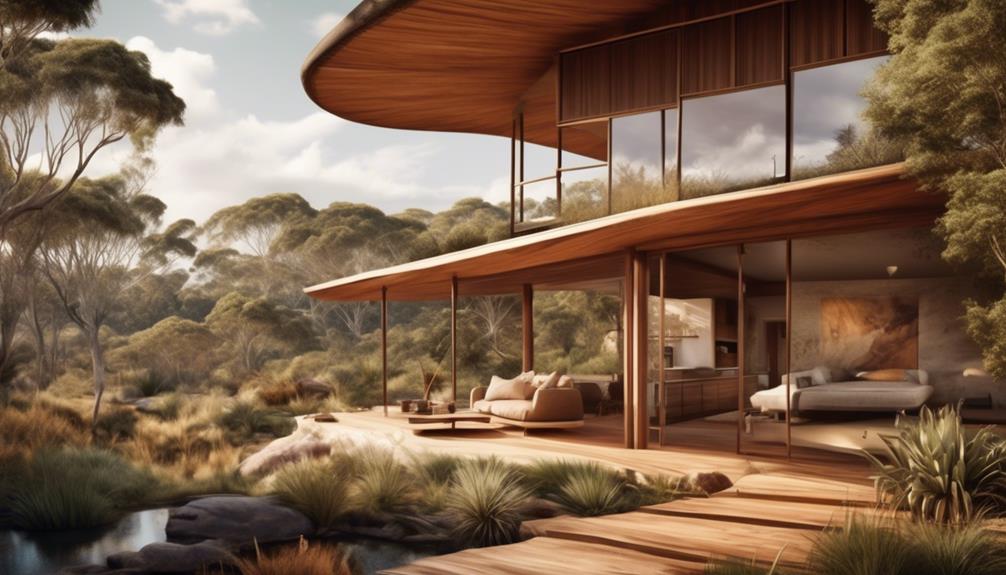
Amidst the diverse landscapes of Australia, Indigenous reserves serve as vital spaces for preserving cultural heritage and fostering community cohesion. These reserves are more than just geographical areas; they represent the enduring connection of Indigenous peoples to their land and the ongoing struggle for indigenous land rights.
- Cultural Heritage Preservation: Indigenous reserves play a crucial role in preserving the cultural heritage of Aboriginal and Torres Strait Islander communities. These areas are home to sacred sites, ancient rock art, and traditional knowledge that have been passed down through generations. By maintaining control over these lands, Indigenous communities can continue their cultural practices and ensure the survival of their traditions for future generations.
- Community Cohesion: The reserves provide a sense of belonging and identity for Indigenous communities. They offer a space where cultural practices can be freely celebrated, and traditional languages can be spoken without fear of erosion. The sense of community and connection to the land within these reserves is essential for the well-being of Indigenous peoples.
- Indigenous Land Rights: Indigenous reserves are a manifestation of the ongoing struggle for indigenous land rights. They represent the recognition of Indigenous peoples' rights to their traditional lands and the acknowledgment of their historical dispossession. Through these reserves, Indigenous communities can exercise control over their lands and protect them from exploitation or encroachment.
Metropolitan Cities
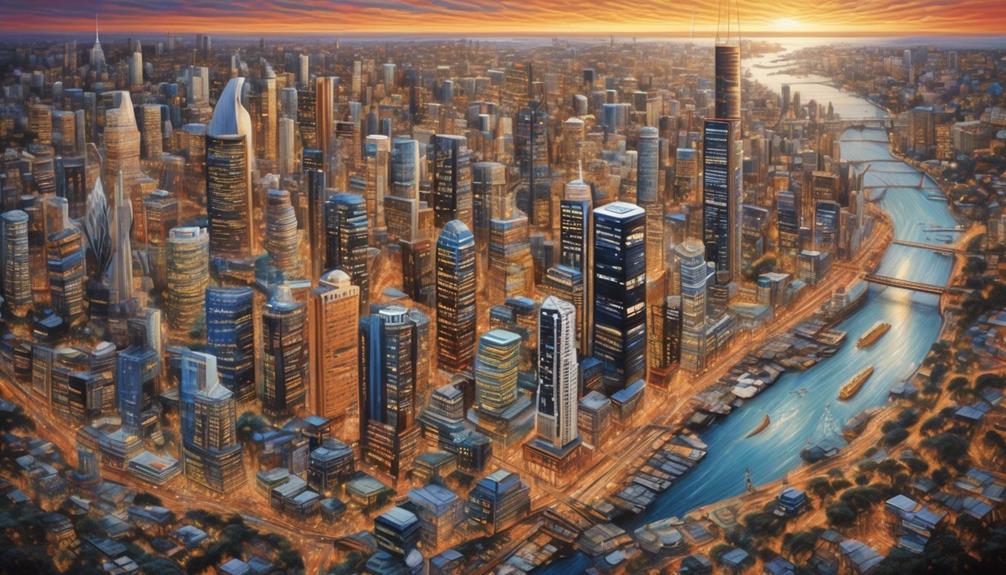
In metropolitan cities across Australia, we see a growing population of urban Aboriginal communities. This shift from traditional lands to urban areas has brought about changes in housing and urbanization patterns for many Aboriginal people.
Understanding the challenges and opportunities that arise from this urbanization process is essential for addressing the diverse needs of Aboriginal communities in metropolitan settings.
Urban Aboriginal Communities
Urban Aboriginal communities in metropolitan cities are vibrant and diverse, reflecting the rich cultural heritage and resilience of Indigenous Australians. As we engage with these communities, we witness the remarkable process of cultural integration within the urban development landscape. This integration is evident in the proliferation of Indigenous art, music, and cultural events that enrich the urban fabric.
However, alongside this cultural vibrancy, we also recognize the socioeconomic challenges faced by these communities. High rates of unemployment and inadequate access to education and healthcare persist, underscoring the need for sustained community engagement and support.
Despite these challenges, the strength and determination of the urban Aboriginal communities are evident in their grassroots initiatives and advocacy efforts, contributing to the broader narrative of Indigenous empowerment and self-determination.
- Vibrant cultural expressions enrich urban spaces
- Ongoing socioeconomic challenges require community support
- Grassroots initiatives demonstrate resilience and determination
Housing and Urbanization
Observing the vibrant cultural expressions and grassroots initiatives of urban Aboriginal communities, we can discern the impact of housing and urbanization on their daily lives in metropolitan cities.
Urbanization brings both opportunities and challenges for Aboriginal people. While metropolitan areas offer access to employment, education, and healthcare, housing affordability remains a pressing issue. As urbanization accelerates, the demand for housing often outstrips the availability of affordable options, leading to housing stress and homelessness within the Aboriginal population. This creates a cycle of disadvantage, impacting social and emotional well-being.
Additionally, rapid urbanization challenges the preservation of cultural connections to land and community, further exacerbating the struggle for identity and belonging.
Addressing housing affordability and urbanization challenges is crucial in ensuring that urban Aboriginal communities can thrive and preserve their cultural heritage within metropolitan cities.
Northern Territories

Located in the northeastern region of Australia, the Northern Territories encompass a diverse array of Aboriginal communities and traditional lands. As we explore this vast and culturally rich area, it becomes evident that Indigenous land rights and land management are crucial aspects of the Northern Territories. The Aboriginal people have a deep connection to the land, and it's inspiring to see their efforts in preserving and managing these ancestral lands for future generations.
- Indigenous Land Rights: The Northern Territories have been at the forefront of the Indigenous land rights movement in Australia. The Aboriginal Land Rights (Northern Territory) Act 1976 was a significant milestone, granting land rights to the Indigenous people. This legislation has paved the way for the establishment of Aboriginal land trusts, enabling communities to manage their traditional lands and resources.
- Cultural Traditions: The Northern Territories are home to a myriad of cultural traditions that have been upheld for generations. The preservation of these customs is fundamental to the identity and heritage of Aboriginal communities. From ancient ceremonies to art forms, the Northern Territories serve as a living repository of Aboriginal cultural richness.
- Language Preservation: The diverse linguistic landscape of the Northern Territories reflects the rich tapestry of Aboriginal languages. Efforts to preserve and revitalize these languages are ongoing, with many communities actively working towards language education and documentation.
In the Northern Territories, the resilience and determination of Aboriginal communities in upholding their cultural traditions and asserting their rights over ancestral lands serve as a testament to the enduring spirit of the Indigenous people.
Central Desert

Nestled within the heart of Australia, the Central Desert region offers a profound glimpse into the cultural richness and traditional heritage of Aboriginal communities. The Central Desert is a vast and arid landscape, covering traditional lands of various Aboriginal groups. These groups have inhabited the region for thousands of years, maintaining a deep connection to the land and preserving their cultural practices.
| Traditional Land Use | Cultural Practices |
|---|---|
| Hunting and Gathering | Dreamtime Stories |
| Nomadic Lifestyle | Rock Art and Ceremonies |
| Water Conservation | Kinship Systems |
The traditional land use in the Central Desert is characterized by hunting and gathering, reflecting the deep understanding of the environment and its resources. Aboriginal communities in the region have historically led a nomadic lifestyle, moving across the desert to follow food sources and seasonal changes. Water conservation has been a crucial aspect of traditional land use in this arid environment, with indigenous practices ensuring the sustainable management of this precious resource.
Cultural practices in the Central Desert are deeply rooted in the Dreamtime stories, which are narratives of creation, spiritual beliefs, and the origin of the natural world. Additionally, rock art and ceremonies are integral to preserving and passing down traditional knowledge and cultural heritage. The kinship systems, governing relationships and responsibilities within the community, play a significant role in maintaining social order and cultural continuity.
The Central Desert stands as a testament to the enduring connection of Aboriginal communities to their traditional lands and cultural practices, offering valuable insights into their way of life and spiritual beliefs.
Suburban Neighborhoods

We've noticed that suburban neighborhoods in Australia have become home to a growing number of Aboriginal communities. This shift is influenced by factors such as housing availability and the presence of crucial community support services.
As we examine these suburban areas, we aim to understand how these communities are thriving and the challenges they may face.
Suburban Housing Availability
In suburban Australia, housing availability varies widely, reflecting the diverse cultural and economic factors shaping these neighborhoods. Suburban housing affordability and community integration play crucial roles in determining the accessibility of housing for Aboriginal communities.
Cultural preservation is also a significant consideration, influencing the design and adaptation of suburban living arrangements to accommodate traditional practices and community cohesion. We've observed that some suburbs provide more affordable housing options, fostering a sense of inclusivity and belonging for Aboriginal families. However, there are still challenges in certain areas where housing availability is limited, impacting community integration and cultural preservation.
Understanding these dynamics is essential for promoting equitable access to suburban housing and nurturing diverse, thriving communities.
Community Support Services
Amidst the varied landscape of suburban housing availability for Aboriginal communities, the presence and accessibility of community support services are vital factors shaping the well-being and resilience of these neighborhoods. Community engagement and cultural preservation are central to the well-being of Aboriginal communities. Accessible healthcare and employment opportunities play a crucial role in ensuring the sustained development of these neighborhoods. Here, we present a snapshot of the community support services available in suburban Aboriginal neighborhoods:
| Support Services | Description | Impact |
|---|---|---|
| Healthcare Services | Accessible healthcare facilities and programs | Improved health outcomes for community members |
| Employment Opportunities | Job training, placement programs | Economic stability and self-sufficiency |
| Cultural Preservation | Cultural centers, language programs | Preservation of traditions and identity |
These support services contribute to the overall resilience and prosperity of the Aboriginal suburban neighborhoods, fostering a sense of community and empowerment.
Western Australia

Located in the western part of Australia, the region of Western Australia is home to a diverse array of Aboriginal communities, each with its own unique cultural heritage and traditions. As we explore the indigenous communities of Western Australia, it's essential to acknowledge the rich tapestry of cultures and histories that have shaped this land for millennia.
- Cultural Diversity: One striking feature of Western Australia's indigenous communities is the remarkable diversity of cultures and languages. From the Noongar people of the southwest to the Yawuru and Bardi people of the Kimberley region, each community has a distinct cultural identity, language, and connection to the land.
- Connection to Country: The deep spiritual and cultural connection to the land, known as 'Country,' is a fundamental aspect of Aboriginal life in Western Australia. This profound relationship is expressed through art, storytelling, and traditional practices that have been passed down through generations.
- Challenges and Resilience: Like many indigenous communities around the world, Aboriginal peoples in Western Australia have faced historical injustices and ongoing socio-economic challenges. Despite this, there's a remarkable resilience and determination within these communities to preserve their cultural heritage and build a better future for their children.
The vibrant indigenous communities of Western Australia offer a window into the richness of Aboriginal culture and traditions. It's crucial to approach these communities with respect, openness, and a willingness to learn from their deep connection to the land and their enduring resilience.
Eastern States
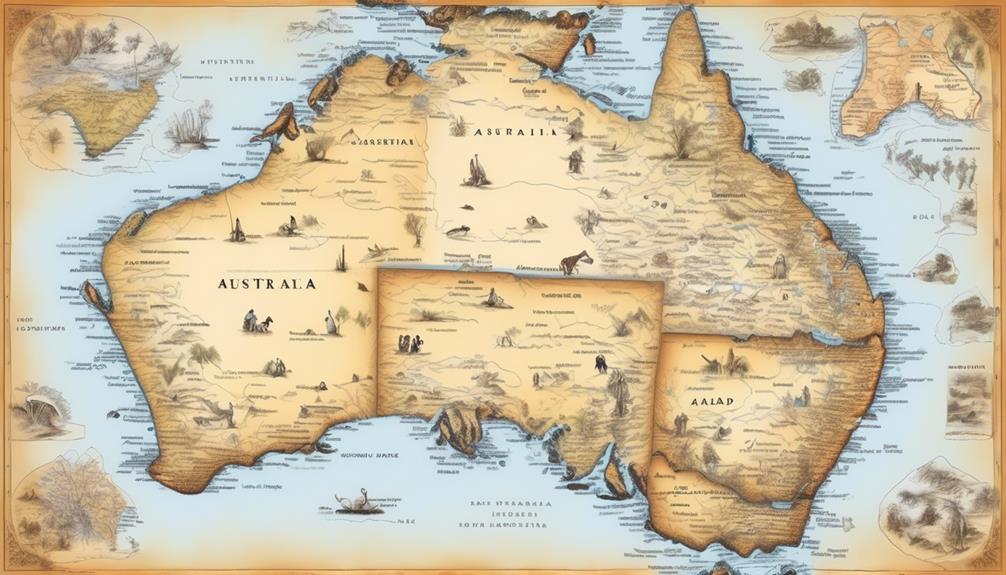
Exploring the Eastern States of Australia reveals a rich tapestry of Aboriginal communities, each with its own distinct cultural heritage and enduring traditions. In our observations, we've noticed that Aboriginal employment opportunities vary across the Eastern States. While there are some success stories, many Aboriginal people face barriers to employment, such as limited access to education and training, as well as discrimination in the workforce. Addressing these issues is crucial for the liberation of Aboriginal communities, as meaningful employment can empower individuals and strengthen the entire community.
In terms of healthcare services, access remains a significant challenge for many Aboriginal communities in the Eastern States. Remote and rural areas often lack adequate healthcare facilities and professionals, resulting in limited access to essential medical services. This issue is compounded by cultural and linguistic barriers, making it difficult for Aboriginal people to seek and receive appropriate healthcare. Recognizing and addressing these disparities is essential for the liberation of Aboriginal communities, as access to quality healthcare is a fundamental human right.
As we continue to explore the Eastern States, it becomes evident that addressing Aboriginal employment opportunities and access to healthcare services is crucial for the empowerment and liberation of Aboriginal communities. By working towards eliminating barriers and implementing culturally sensitive policies, we can support the resilience and well-being of Aboriginal people across the Eastern States.
Indigenous Housing
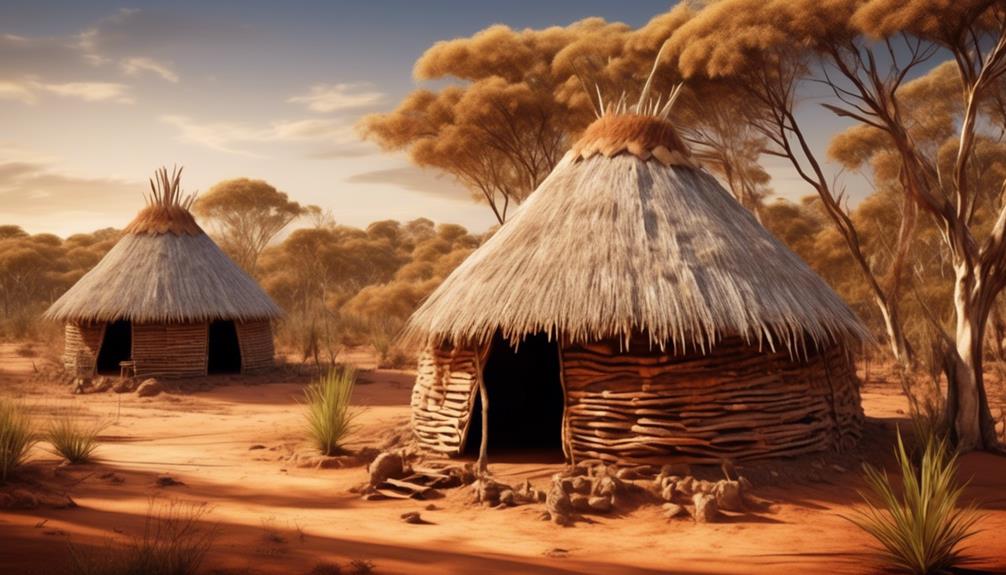
As we shift our focus to Indigenous housing, it becomes clear that the living conditions of Aboriginal communities in the Eastern States are intricately connected to their employment opportunities and access to healthcare services. The challenges of housing in remote areas are significant, contributing to overcrowding and inadequate infrastructure. This, in turn, affects the overall well-being and health of the community members.
- Housing Challenges: The lack of suitable housing in remote Aboriginal communities is a pressing issue. Many houses are overcrowded, leading to increased health risks and affecting the privacy and well-being of individuals and families. Additionally, limited access to essential amenities such as clean water and sanitation further exacerbates the housing challenges faced by Indigenous communities.
- Remote Areas and Traditional Architecture: In remote areas, there's a growing movement to incorporate traditional Aboriginal architecture into housing projects. This not only addresses the practical housing needs but also serves as a means of cultural preservation. By utilizing traditional building methods and materials, such as mud-brick and thatched roofing, communities can maintain their cultural identity while creating sustainable housing solutions.
- Cultural Preservation: Indigenous housing initiatives are increasingly recognizing the importance of cultural preservation. Efforts to involve local community members in the design and construction process help ensure that traditional knowledge and practices are integrated into housing projects, fostering a sense of pride and connection to their heritage.
Understanding the housing challenges and incorporating traditional architecture for cultural preservation is vital in addressing the housing needs of Aboriginal communities in the Eastern States.
Traditional Homelands

In our observations of Aboriginal communities in the Eastern States, the concept of traditional homelands holds significant cultural and historical importance. Traditional land ownership is deeply intertwined with the identity and spirituality of Aboriginal peoples. These homelands aren't just physical spaces; they're repositories of ancestral knowledge, cultural practices, and connections to the land. It's evident that the preservation of these homelands is crucial for the well-being of Aboriginal communities.
Cultural preservation efforts play a pivotal role in maintaining the integrity of traditional homelands. The ongoing struggle for recognition and protection of these lands is a testament to the resilience and determination of Aboriginal peoples. Through cultural events, storytelling, and artistic expressions, the significance of these homelands is kept alive. The passing down of traditional knowledge and practices from elders to the younger generations ensures the continuity of cultural ties to the land.
However, traditional homelands face numerous challenges, including encroachment by external developments and environmental degradation. The fight for land rights and the preservation of these homelands is an ongoing battle. It's crucial for broader society to recognize the significance of traditional homelands and support the efforts of Aboriginal communities in safeguarding these vital cultural and historical spaces.
The recognition and protection of traditional homelands are essential steps towards reconciliation and liberation for Aboriginal peoples across Australia.
Indigenous Housing Programs
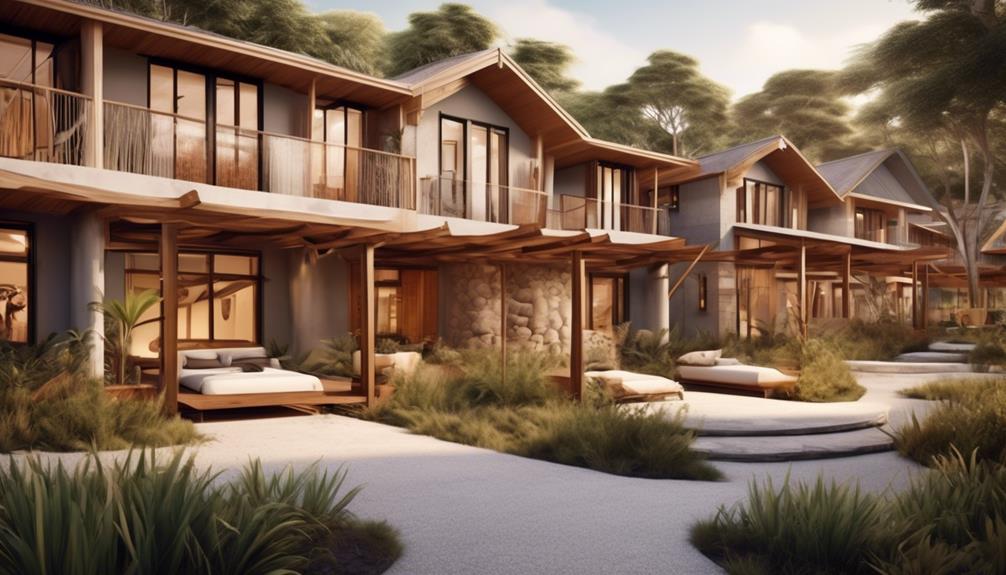
The significance of traditional homelands for Aboriginal communities underscores the critical need for effective Indigenous housing programs that not only address the current housing challenges but also respect and support the cultural and historical connections to the land. Indigenous housing programs play a pivotal role in addressing the housing challenges faced by Aboriginal communities. These programs are designed to not only provide adequate housing but also to foster a sense of community, belonging, and cultural identity.
- Community-Centered Approach: Indigenous housing programs often adopt a community-centered approach, involving local community members in the planning, construction, and maintenance of housing. This approach ensures that the housing reflects the cultural and social needs of the community, strengthening the connection to traditional lands and fostering a sense of ownership and pride.
- Sustainable and Affordable Housing Solutions: Many Indigenous housing programs focus on sustainable and affordable housing solutions that are tailored to the specific needs of Aboriginal communities. These programs aim to address overcrowding, inadequate infrastructure, and poor living conditions, thereby improving the overall quality of life for Indigenous peoples.
- Economic Opportunities: Effective Indigenous housing programs also create economic opportunities within Aboriginal communities. By engaging community members in construction, maintenance, and management of housing projects, these programs contribute to skill development, employment, and economic empowerment, thereby promoting self-sufficiency and resilience within the community.
Frequently Asked Questions
What Are the Specific Cultural Practices and Traditions of the Aboriginal People in These Different Living Environments?
We observe that the specific cultural practices and traditions of the Aboriginal people in various living environments encompass a deep connection to the land, ceremonial rituals, and art as a form of storytelling.
These traditions are integral to their identity and survival, despite facing political challenges.
The preservation of traditional living and land connection is crucial for the Aboriginal people's cultural resilience and liberation.
How Do Aboriginal Communities in These Areas Access Healthcare and Education Resources?
Accessing healthcare and education resources in Aboriginal communities is crucial for their well-being and development. We've observed that some communities face challenges in accessing these resources due to geographical remoteness and limited infrastructure.
This impacts the quality of healthcare and education available. Understanding these barriers is essential for developing culturally sensitive and effective strategies to improve access for Aboriginal communities.
What Are the Economic Opportunities Available to Aboriginal People in These Different Living Environments?
Economic opportunities for Aboriginal people vary across different living environments. In urban areas, there are job markets and access to education and training.
In rural and remote areas, opportunities may be limited, impacting economic stability. Despite this, cultural practices often create avenues for economic development, such as through traditional arts, crafts, and tourism.
Understanding these dynamics is crucial to empowering Aboriginal communities and fostering economic growth while preserving cultural heritage.
How Do Aboriginal Communities in These Areas Maintain Connection to Their Traditional Lands and Cultural Heritage?
Maintaining connection to traditional lands and cultural heritage is vital for Aboriginal communities. Through traditional practices, storytelling, and art, we preserve our rich heritage.
However, accessing healthcare remains a challenge, impacting our ability to uphold these traditions. It's estimated that only 1 in 3 Aboriginal people have regular access to healthcare services.
This statistic underscores the ongoing struggle to balance cultural preservation with modern healthcare needs, a complex issue that demands attention and action.
What Are the Social and Political Challenges Faced by Aboriginal People in These Different Living Environments?
Social inequality and political representation are critical issues for Aboriginal people.
In our experience, these challenges manifest differently across living environments.
In urban areas, we face discrimination and lack of access to resources.
In remote communities, we struggle with limited infrastructure and services.
Both settings require tailored solutions to address these disparities.
Our cultural understanding informs the need for equitable opportunities and fair representation in decision-making processes.
Conclusion
After exploring where Aboriginal people live in Australia, it's clear that their connection to the land runs deep. In fact, over 20% of Indigenous Australians live in remote communities, maintaining their traditional way of life.
This statistic paints a picture of a resilient and enduring culture, rooted in the unique landscapes of the Australian continent. It's a testament to the strength and resilience of the Aboriginal people and their deep connection to their ancestral lands.
Nayeli is our dedicated Editor in Chief, bringing her passion for words and keen editorial eye to every piece of content we produce. With years of experience in the field, she ensures that every article and publication meets the highest standards of quality and clarity. Nayeli’s commitment to storytelling and her deep understanding of our mission make her an invaluable leader in our team.
Aboriginal
Can Native American Grow Beards
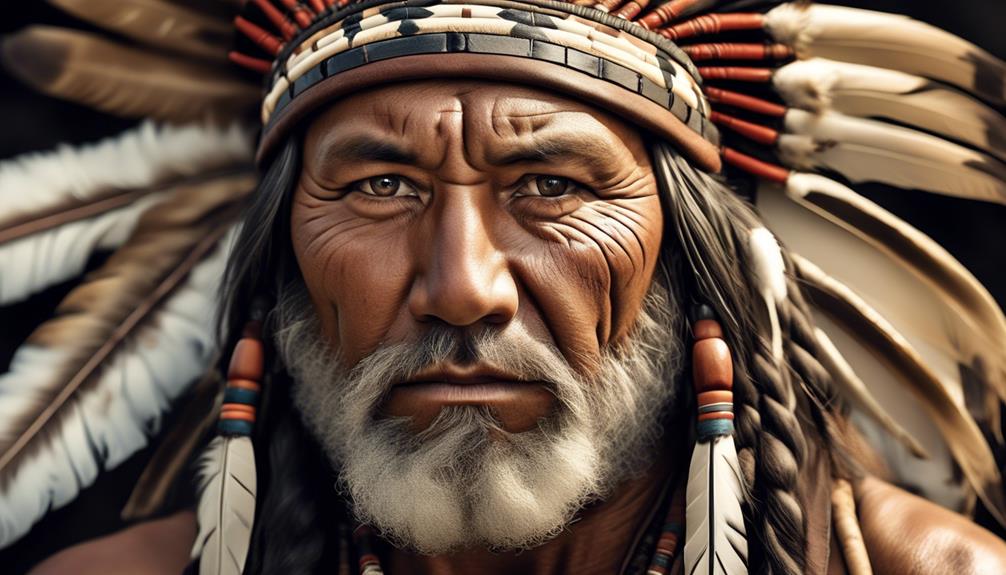
We all know that one Native American friend who proudly rocks an impressive beard, proving the misconception that Native Americans can’t grow facial hair wrong.
But is this just an exception, or do Native Americans as a group have a unique relationship with facial hair?
The answer to this question may surprise you, as we explore the historical, genetic, and cultural aspects of Native American beard growth.
Join us as we unravel the complexities surrounding this topic and uncover the truths behind Native American facial hair.
Key Takeaways
- Native American facial hair varied across tribes and regions, with different grooming customs and standards introduced through colonial influence.
- Beard patterns in Native American populations can be influenced by ancestral genetics, as well as environmental factors such as diet and lifestyle.
- Facial hair holds spiritual and social significance in Native American communities, representing masculinity, wisdom, and connection to nature.
- There are common myths and misconceptions about Native American beards, including the false belief that all Native American men can't grow beards and that they historically didn't cultivate facial hair, when in fact facial hair holds cultural significance in many tribes.
Historical Perspectives on Native American Facial Hair
Historically, depictions of Native American facial hair have varied widely across different tribes and regions, reflecting diverse cultural and grooming practices. Traditional practices play a significant role in understanding the historical perspectives on Native American facial hair.
For many Native American tribes, facial hair was a symbol of masculinity, wisdom, and strength. However, it's essential to acknowledge the colonial influence on these traditional practices. The arrival of European settlers brought new grooming customs and standards that influenced the perceptions of facial hair within Native American communities.
Additionally, genetic diversity among Native American tribes also played a crucial role in the variation of facial hair patterns. Some tribes exhibited a propensity for full, lush beards, while others had less facial hair due to genetic differences.
The cultural significance of facial hair in Native American communities goes beyond mere aesthetics; it often held spiritual and social significance, with specific grooming rituals and practices associated with facial hair.
Understanding the historical perspectives on Native American facial hair requires a nuanced appreciation of traditional practices, colonial influence, genetic diversity, and cultural significance.
Genetics and Beard Growth in Native American Populations
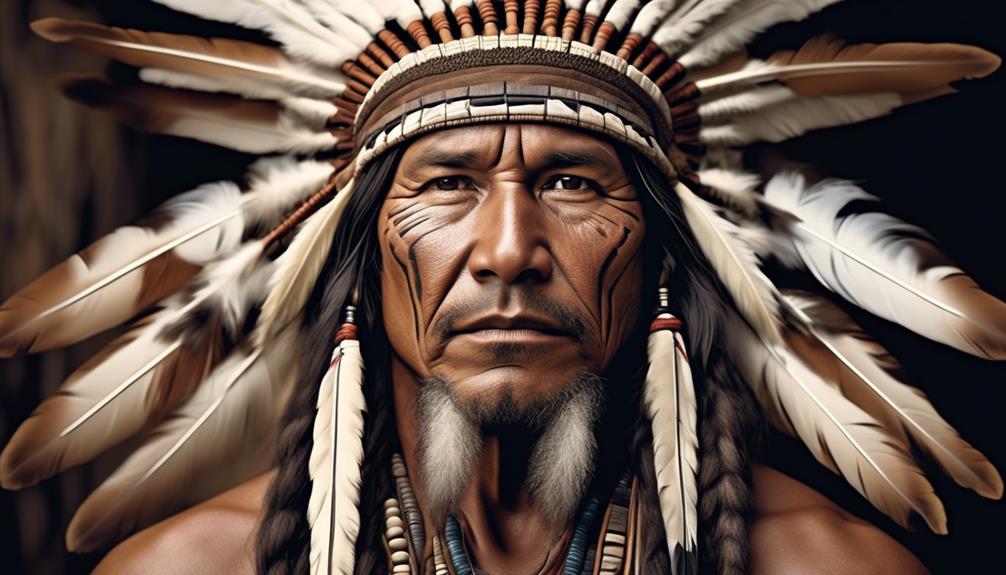
Genetic research has shed light on the varying patterns of beard growth among different Native American populations, revealing a complex interplay of genetic factors influencing facial hair. The genetic variations influencing beard patterns in Native American populations are a subject of growing interest and research.
Here are three key points to consider:
- Ethnic Diversity: Native American populations are incredibly diverse, comprising numerous distinct ethnic groups, each with its own genetic makeup. This diversity contributes to the wide range of beard patterns observed among Native American individuals.
- Influence of Ancestral Genetics: The beard patterns of Native American individuals can be influenced by the genetic traits inherited from their ancestors. The interplay of these ancestral genetic variations can result in a spectrum of beard growth patterns within Native American communities.
- Environmental Factors: While genetic variations play a significant role in beard growth patterns, environmental factors such as diet, lifestyle, and exposure to certain hormones can also impact the development of facial hair in Native American populations.
Understanding the genetic and environmental factors that influence beard growth patterns in Native American populations is crucial for gaining insight into the complexities of human genetics and evolution.
Cultural Traditions and Symbolism of Facial Hair
The cultural significance of facial hair among Native American communities reflects a rich tapestry of traditions and symbolism deeply rooted in their heritage and customs.
Facial hair symbolism varies across different Native American tribes and can hold diverse meanings. In some tribes, facial hair is seen as a symbol of masculinity and wisdom, with the growth of a beard signifying the transition from adolescence to adulthood. It can also be a representation of connection to nature, as facial hair growth is often associated with the natural world and the passage of time. Additionally, the grooming and styling of facial hair may hold specific cultural significance, such as the intricate designs and braids seen in some Native American traditions, representing individual and tribal identity.
Moreover, genetic factors may play a role in the ability of Native American individuals to grow facial hair, but the cultural significance often transcends mere biological traits. It's important to recognize that the traditions and symbolism surrounding facial hair in Native American communities are deeply ingrained in their cultural heritage and are significant aspects of their identity.
Understanding and respecting these cultural nuances is essential in appreciating the diversity and richness of Native American traditions.
Common Myths and Misconceptions About Native American Beards
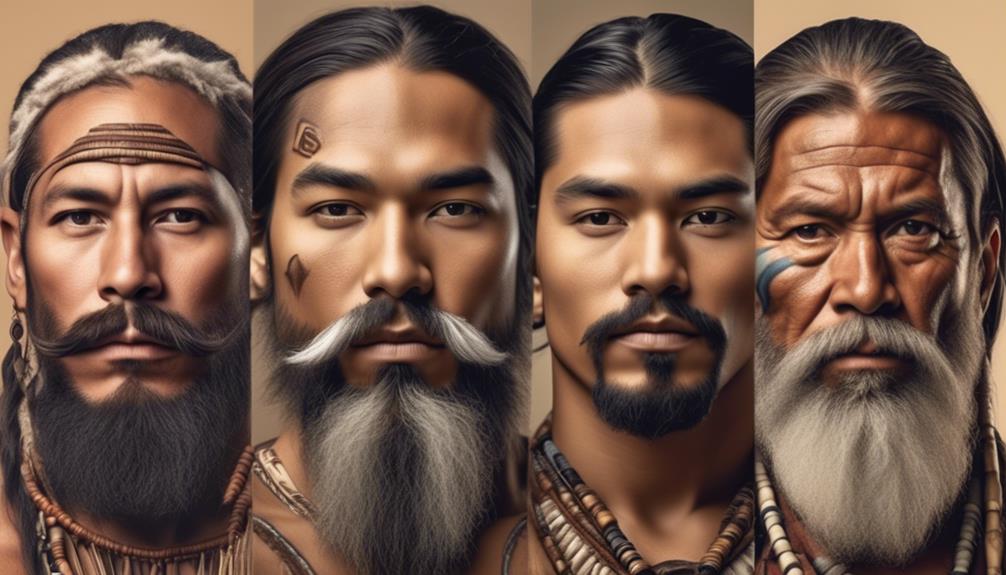
Common myths and misconceptions about Native American beards often stem from a lack of understanding of the diverse cultural traditions and symbolism associated with facial hair within different Native American tribes. It's essential to debunk these myths and understand the societal perceptions surrounding Native American beards.
- Myth Debunking: One common misconception is that all Native American men can't grow beards. This is false, as genetics determine an individual's ability to grow facial hair, and Native American men exhibit the same range of facial hair growth as men from other ethnic backgrounds.
- Societal Perceptions: Another myth is that Native American men historically didn't cultivate facial hair. However, historical records and cultural artifacts demonstrate that many Native American tribes had traditions and rituals associated with facial hair, including beard grooming and styling.
- Cultural Significance: Contrary to the misconception that Native American beards are insignificant, facial hair holds cultural significance in many tribes. It can symbolize maturity, wisdom, and status within the community, challenging the myth that facial hair lacks importance in Native American culture.
Understanding the cultural diversity and significance of facial hair within Native American tribes helps debunk these myths and misconceptions, fostering a more accurate and respectful understanding of Native American traditions.
Contemporary Perspectives and Practices Regarding Beard Growth
In contemporary Native American culture, the significance and practice of beard growth continue to reflect the diverse traditions and values of different tribes. While some Native American men have embraced modern grooming practices, including beard grooming as a part of their personal care routine, others have chosen to uphold traditional perspectives on beard growth.
In modern fashion, there's been a resurgence of interest in facial hair, including beards, and this trend has been embraced by some Native American men as a way to express their individual style and cultural pride.
For some, growing a beard is a way of connecting with their heritage and expressing their masculinity. However, it's essential to recognize that not all Native American men can or choose to grow beards due to genetic factors or personal preferences.
Additionally, the significance of beard growth may vary among different tribes, with some placing greater importance on facial hair as a symbol of wisdom and maturity, while others may not view it as a significant cultural practice.
Frequently Asked Questions
What Are Some Traditional Grooming Practices for Native American Men With Facial Hair?
Traditional techniques for Native American men with facial hair include using natural oils and herbs for beard care. These grooming practices hold cultural significance, reflecting connection to nature and heritage. Maintaining facial hair is often a symbol of maturity and wisdom in many Native American traditions.
The grooming process embraces a sense of pride and respect. These traditional methods provide insight into the rich history and values of Native American communities.
Are There Any Specific Cultural Taboos or Beliefs Surrounding Beard Growth in Certain Native American Tribes?
Cultural beliefs and grooming practices vary among Native American tribes, influencing attitudes towards beard growth. Some tribes view beards as a symbol of wisdom and masculinity, while others have traditional taboos surrounding beard growth.
Historical figures and contemporary trends also shape perceptions. It's important to approach this topic with respect and understanding of the diverse cultural beliefs and practices within Native American communities when discussing beard growth rates and the significance of beards in different tribes.
Do Native American Men Experience Different Rates of Beard Growth Compared to Men of Other Ethnicities?
Beard growth varies among ethnic groups due to genetic factors. Studies suggest Native American men may experience different rates of beard growth compared to other ethnicities.
Grooming practices, cultural taboos, and historical figures influence attitudes toward facial hair. Understanding these nuances fosters respect for diverse perspectives on masculinity.
Are There Any Historical Figures or Leaders in Native American History Known for Their Impressive Facial Hair?
Native American leaders have been known for their impressive facial hair, reflecting grooming practices and cultural taboos.
While historical depictions often emphasize facial hair, contemporary opinions vary on beard growth rates and ethnic differences.
In popular culture, Native American figures are often portrayed with prominent beards, adding to the mystique.
It's essential to approach the topic with respect for diverse cultural traditions and understand that perceptions of facial hair can differ across communities.
How Do Contemporary Native American Men Feel About the Increasing Trend of Beard Grooming and Styling in Popular Culture?
Contemporary perspectives on beard grooming trends among Native American men vary. Some embrace it as a form of self-expression and cultural pride, while others may view it through the lens of cultural beliefs and taboo restrictions.
The increasing trend of beard grooming and styling in popular culture has sparked conversations within our communities about the intersection of tradition and modern influences.
It's a complex and evolving aspect of our cultural identity.
Conclusion
In conclusion, while there may be historical, genetic, and cultural factors that influence the growth of facial hair in Native American populations, the irony lies in the fact that the question of whether Native Americans can grow beards is ultimately irrelevant.
Just like any other group of individuals, some Native Americans can grow beards, and some cannot. It's important to move beyond stereotypes and recognize the diversity and individuality within Native American communities.
Mary is a passionate writer who brings creativity and a fresh perspective to our team. Her words have the power to captivate and inspire, making her an essential contributor to our content. Mary’s commitment to storytelling and dedication to promoting Indigenous culture ensures that her work touches the hearts of our readers. We’re fortunate to have her as part of our team.
Aboriginal
Native Australians
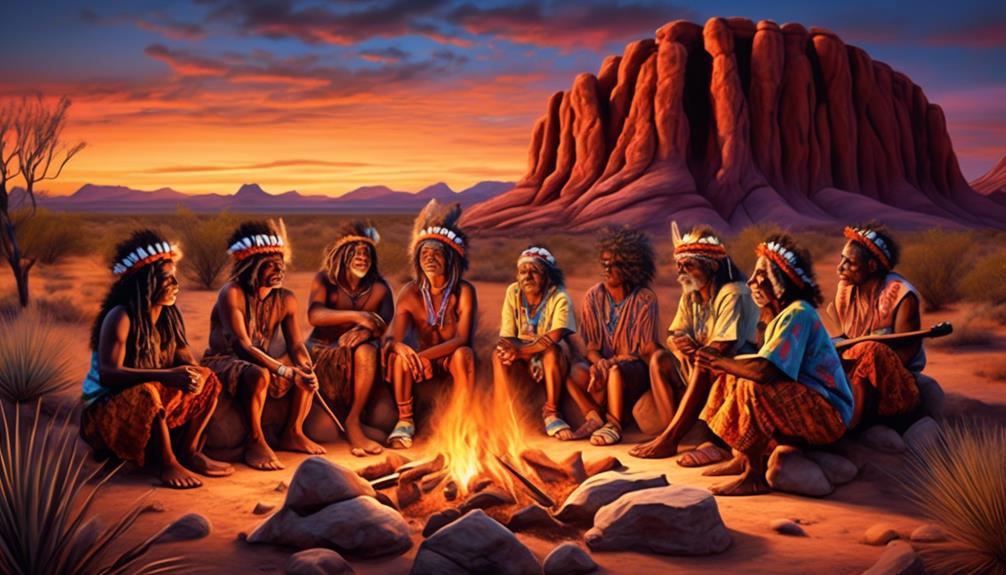
Exploring the diverse cultures around the world, one cannot help but be intrigued by the rich history and traditions of Indigenous Australians. Their strong connection to the land and the captivating Dreamtime stories passed down through generations are truly fascinating.
However, the impact of colonization and the ongoing struggle for political representation and recognition of rights have brought about significant challenges for this community. Despite these obstacles, the resilience and activism of Native Australians continue to shape their cultural identity and influence the broader Australian society.
Key Takeaways
- Aboriginal and Torres Strait Islander peoples have a long history in Australia, with evidence suggesting they arrived around 65,000 years ago.
- Migration patterns are deeply connected to the land, sea, and environment, shaping traditional practices and connections to Country.
- The imposition of Western values and practices has eroded traditional cultural identity, but efforts are being made to preserve and revitalize cultural identity within Indigenous communities.
- The forced removal of Indigenous children from their families and communities during the Stolen Generations has had a lasting impact on cultural identity, and addressing the wounds caused by this period is crucial for healing and reconciliation.
Origins and Migration
The diverse Aboriginal and Torres Strait Islander peoples of Australia have a rich and complex history of origins and migration that predates recorded human history.
The origins debate surrounding Indigenous Australians is a contentious and sensitive topic. It involves discussions about the timing of their arrival in Australia, which is a subject of ongoing research and dialogue among scholars, scientists, and Indigenous communities. One prevalent theory suggests that the first inhabitants arrived around 65,000 years ago, challenging previous notions of when humans migrated out of Africa. The evidence for this early migration includes archaeological findings and genetic studies, which have provided valuable insights into the deep roots of Indigenous Australian cultures.
Migration patterns of the Aboriginal and Torres Strait Islander peoples are deeply interconnected with the land, sea, and environment. These patterns are integral to their spiritual and cultural identities, shaping their traditional practices and connections to Country. The concept of 'Country' encompasses not only the physical land but also the spiritual and cultural relationship that Indigenous Australians have with their ancestral territories. The intricate knowledge of the land and sea, passed down through generations, reflects the enduring connection to place and the wisdom derived from sustained interactions with the environment.
Understanding the origins and migration of Indigenous Australians requires a respectful and inclusive approach that centers Indigenous voices and perspectives. It's essential to acknowledge the complexities and diversity of Indigenous cultures and histories, honoring the resilience and continued presence of the world's oldest living cultures.
Traditional Cultural Practices
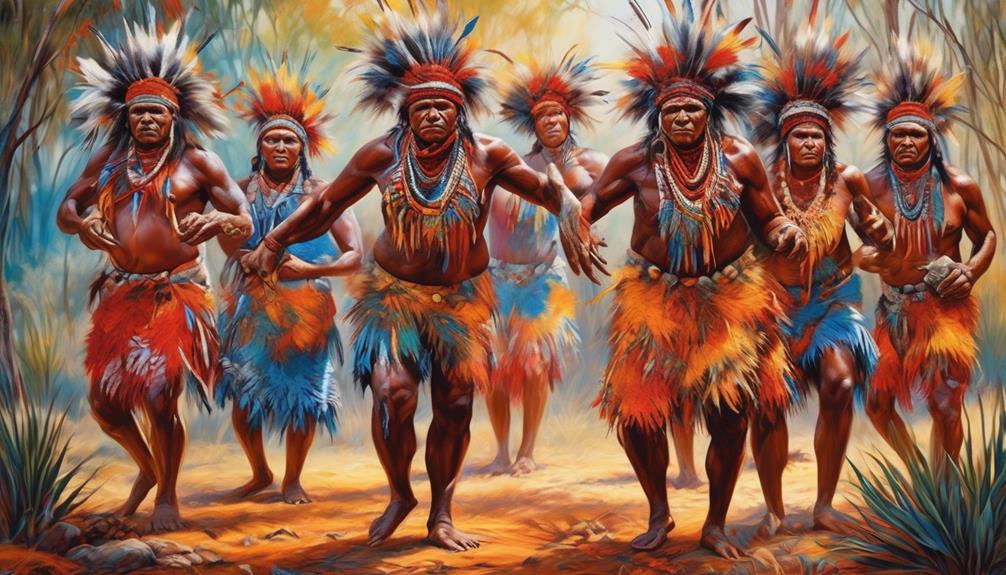
Deeply rooted in our ancestral connection to Country, traditional cultural practices are integral to the identity and resilience of Indigenous Australian peoples. These practices are a living expression of our continual relationship with the land, passed down through generations, and remain an essential part of our contemporary existence.
- Traditional Ceremonies: Our ceremonies are sacred and mark significant events, such as initiation, marriage, and seasonal changes. They connect us to our ancestors and the spiritual essence of Country, fostering a sense of belonging and continuity.
- Storytelling Traditions: Storytelling is a fundamental way of sharing knowledge, history, and spiritual beliefs. Through oral narratives, we uphold our cultural values and teachings, preserving the wisdom of our elders for future generations.
- Cultural Dance and Traditional Art: Dance is a powerful medium for expressing cultural stories, connections to the land, and spiritual beliefs. Each movement holds deep symbolic meaning, reflecting our intimate relationship with the natural world. Similarly, traditional art forms, such as dot painting and carving, carry the essence of our cultural heritage, depicting Dreaming stories and the interconnectedness of all living things.
These practices aren't relics of the past but are vital components of our contemporary Indigenous identity. Embracing and perpetuating these traditions is a testament to our strength, resilience, and unwavering connection to the land, which sustains and nourishes us.
Dreamtime Stories and Beliefs
Engaging in Dreamtime storytelling and embracing traditional beliefs is an essential aspect of our cultural heritage, fostering a deep connection to our ancestral wisdom and spiritual understanding. Dreamtime stories hold immense cultural significance for us as Native Australians. These stories aren't just myths or legends; they form the foundation of our spiritual beliefs and provide a profound understanding of the world around us. Through these stories, we learn about the creation of the land, the animals, and our people, as well as the moral lessons and values that guide our lives.
Our storytelling traditions are passed down through generations, preserving the knowledge and wisdom of our ancestors. These stories aren't merely entertainment; they're sacred narratives that connect us to our past, present, and future. Each story is a thread woven into the rich tapestry of our cultural identity.
The Dreamtime stories aren't confined to a distant past; they exist in an ongoing present, shaping our understanding of the world and our place within it. They remind us of our responsibilities to the land, the spirits, and each other. By sharing these stories, we not only preserve our cultural heritage but also invite others to appreciate the depth of our spiritual beliefs and the interconnectedness of all life. This exchange of knowledge and understanding is essential for the liberation of all peoples, fostering respect and appreciation for diverse worldviews.
Impact of Colonization

Colonization has significantly impacted our traditional way of life, reshaping our cultural practices and challenging the preservation of our ancestral knowledge. The impact of colonization on Native Australians is profound, affecting every aspect of our existence. Here are some key points to consider:
- Cultural Assimilation
- The imposition of Western values and practices has led to the erosion of our traditional cultural identity. The pressure to conform to Western norms has resulted in the loss of unique customs and spiritual beliefs, threatening the very essence of our cultural heritage.
- The forced assimilation into European ways of life has created a sense of displacement and disconnection from our own traditions, causing internal conflicts as we strive to navigate between our indigenous roots and the dominant culture.
- Identity Preservation
- Despite the challenges posed by colonization, there's a resilient effort within our communities to preserve and revitalize our cultural identity. This includes reclaiming traditional languages, reviving ancient ceremonies, and promoting indigenous art forms as a means of asserting our unique cultural presence.
- Traditional Knowledge Revitalization
- The intergenerational transmission of traditional knowledge has been disrupted due to the impact of colonization. Efforts are underway to reclaim and revitalize this knowledge, ensuring that our ancestral wisdom and practices aren't lost to future generations.
As Native Australians, navigating the impact of colonization is an ongoing journey towards reclaiming our cultural autonomy and revitalizing our ancestral heritage.
Stolen Generations
The impact of colonization has deeply affected our communities, and one of the most distressing consequences is the era known as the Stolen Generations. This dark period in our history refers to the forced removal of Indigenous children from their families and communities by government agencies and church missions. The trauma inflicted during this time continues to reverberate through generations, leading to what we call intergenerational trauma. The pain and suffering of those who were taken, as well as their families, have had a lasting impact on our people, affecting our cultural identity, connection to land, and spiritual well-being.
However, despite this painful history, our communities are resilient and committed to healing and reconciliation. We're actively engaged in addressing the deep wounds caused by the Stolen Generations. Through cultural revitalization programs, community healing initiatives, and advocacy for truth and justice, we're working towards healing the scars of the past.
Furthermore, the process of reconciliation is ongoing, as we strive to rebuild trust and create a more inclusive and equitable future for all Australians. This journey towards healing and reconciliation is a collective effort that involves acknowledging past wrongs, fostering understanding, and creating avenues for redress and healing. It's through these efforts that we hope to create a more just and compassionate society for future generations.
Land Rights and Sovereignty
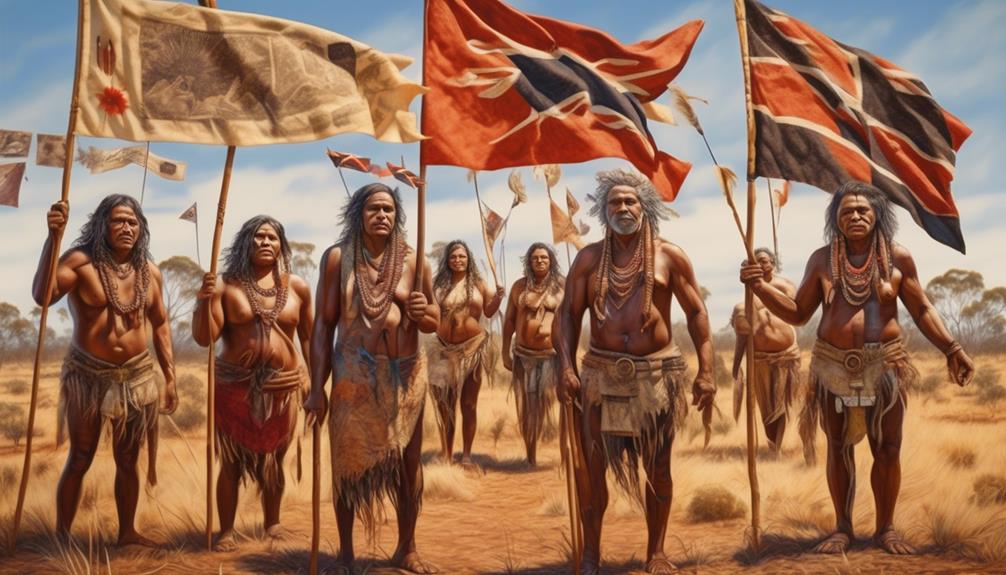
Asserting our rights to land and sovereignty is a crucial aspect of preserving our cultural heritage and ensuring the well-being of future generations. Our connection to the land is deeply rooted in our identity, spirituality, and traditions. As Indigenous Australians, the struggle for land rights and sovereignty has been central to our ongoing journey of cultural revival and resilience.
- Preservation of Traditional Land Stewardship
- Our ancestral lands hold profound spiritual and cultural significance, and it's our inherent responsibility to protect and nurture these sacred spaces.
- Through the recognition of our traditional land stewardship practices, we aim to ensure sustainable management of natural resources, honoring the wisdom passed down through generations.
- By reclaiming our rights to traditional lands, we're reclaiming our ability to practice our cultural traditions and maintain our spiritual connections to the land.
- Sovereignty and Self-Determination
- Sovereignty empowers us to govern our own affairs, make decisions that affect our communities, and revitalize our languages, customs, and legal systems.
- Upholding our sovereignty is essential for the preservation of our unique cultural identities and the autonomy to shape our collective future.
- Through the assertion of our sovereignty, we seek to create pathways for self-determination, allowing us to address the social, economic, and political challenges faced by our communities.
- Cultural Revival and Well-being
- Restoring our rights to the land is foundational to the revival and preservation of our cultural practices, languages, and knowledge systems.
- The recognition of our land rights contributes to the well-being of our communities, fostering pride, resilience, and a sense of belonging.
- As we continue to assert our land rights and sovereignty, we envision a future where our cultural heritage thrives, and our future generations can flourish in harmony with the land.
Contemporary Challenges
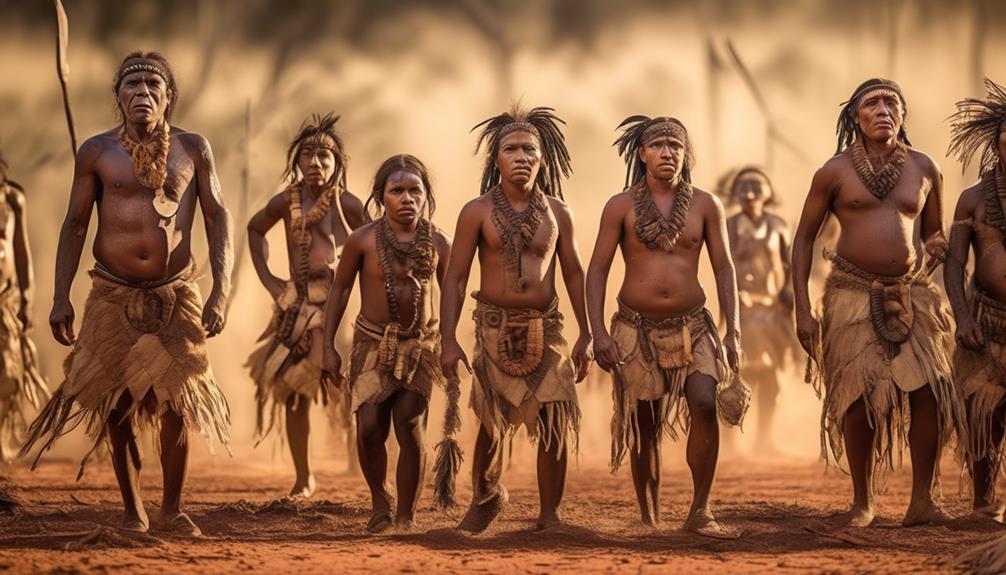
Facing contemporary challenges, we strive to address the complex issues that impact our communities, seeking sustainable solutions rooted in our cultural resilience and collective strength.
Intergenerational trauma continues to cast a long shadow over our people, stemming from historical injustices and ongoing systemic marginalization. Its impact is deeply felt, manifesting in mental health disparities, substance abuse, and family breakdowns. We're committed to addressing this trauma by fostering culturally sensitive healing practices and providing accessible mental health support to our community members.
Moreover, social inequality remains a pervasive issue, perpetuating disparities in health, education, and employment. We're actively engaging in advocacy efforts to dismantle structural barriers and promote equitable access to resources. By amplifying our voices and advocating for policy reforms, we aim to create pathways for our youth to thrive and contribute to our collective prosperity.
In navigating these contemporary challenges, we draw strength from the wisdom of our elders and the resilience of our ancestors. We're harnessing our cultural traditions and knowledge systems to guide us in finding holistic solutions that honor the interconnectedness of all aspects of our lives.
Through community-led initiatives and partnerships, we're fostering sustainable change that uplifts our people and ensures a future where our cultural heritage flourishes, and our communities thrive.
Cultural Revival and Preservation

Navigating the complexities of contemporary challenges, we're actively revitalizing and preserving our cultural heritage to ensure its enduring legacy within our communities. This ongoing endeavor is crucial in maintaining the richness and diversity of our traditions, enabling us to pass down our ancestral wisdom to future generations. As we engage in the cultural revival and preservation, we recognize the significance of traditional knowledge and practices in shaping our identity and fostering a sense of belonging.
- Celebrating Our Heritage: Embracing our cultural revival involves organizing vibrant festivals and gatherings that showcase our traditional music, dance, art, and storytelling. By inviting people from diverse backgrounds to participate, we foster understanding and appreciation for our heritage.
- Transmitting Ancestral Wisdom: We're committed to preserving our traditional knowledge by documenting oral histories, teachings, and rituals. Through educational programs and workshops, we aim to impart this wisdom to our youth, ensuring the continuity of our cultural practices.
- Safeguarding Sacred Sites: We're dedicated to protecting our sacred landscapes and significant sites, which hold deep spiritual and cultural importance. By advocating for their conservation and promoting sustainable practices, we honor our connection to the land and its role in our cultural revival.
In our pursuit of cultural revival and preservation, we invite all who share our commitment to join us in safeguarding the legacy of our ancestors and nurturing the cultural vitality of our communities.
Contributions to Australian Society
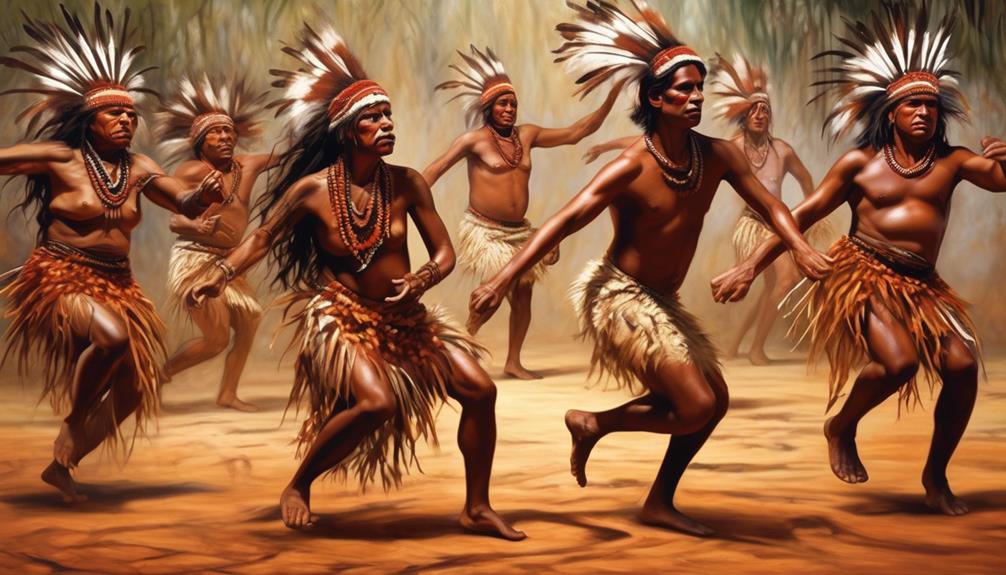
As we explore the contributions of Native Australians to Australian society, we see the profound impact of their art and music, which serve as a vibrant expression of their cultural identity.
Additionally, their traditional medicine practices have influenced healthcare approaches, offering valuable insights into holistic wellness.
Furthermore, their deep connection to the land has led to sustainable stewardship practices that benefit not only their communities but also the wider Australian society.
Art and Music
Throughout history, indigenous Australians have made significant contributions to Australian society through their art and music. Indigenous art reflects a deep connection to the land, using traditional techniques and symbols to convey stories of cultural significance.
Traditional music, passed down through generations, continues to be an integral part of indigenous ceremonies and rituals, carrying the essence of their spirituality and heritage.
These artistic expressions serve as a way of preserving and sharing their rich cultural traditions with the wider Australian community. Indigenous art and music not only contribute to the diversity of Australian culture but also challenge mainstream perceptions, fostering a deeper understanding and appreciation of the indigenous experience.
It's through these artistic forms that indigenous Australians continue to assert their presence and resilience in the face of historical and ongoing challenges.
Traditional Medicine
Traditional medicine has been an integral part of indigenous Australian society, embodying centuries of knowledge and practices that have contributed significantly to the broader Australian healthcare landscape.
Herbal remedies, healing practices, traditional knowledge, and plant medicine are core components of traditional Aboriginal healthcare. These healing methods are rooted in a deep understanding of the land, seasons, and the interconnectedness of all living beings.
Traditional healers, often referred to as Ngangkari, hold profound knowledge of the healing properties of various plants and the intricate ways to administer them for different ailments.
The use of traditional medicine isn't just about physical health but also encompasses spiritual and emotional well-being. It's important to recognize the value of these ancient healing practices and work towards integrating them into the broader healthcare system, respecting the wisdom and expertise of indigenous healers.
Land Stewardship
We, as indigenous Australians, have been entrusted with the vital responsibility of nurturing and safeguarding the land, drawing upon our deep connection to the earth and its natural rhythms to contribute to the well-being of Australian society.
Our sustainable practices and environmental stewardship are rooted in our profound respect for the land, passed down through generations. Through sustainable land management, we strive to maintain a delicate balance between human needs and the preservation of the natural environment.
Our holistic approach to environmental stewardship involves not only conserving the land but also sharing our traditional ecological knowledge with the wider community. By integrating sustainable practices into modern society, we aim to foster a harmonious relationship between humans and the land, ensuring the well-being of all living beings for generations to come.
Indigenous Art and Music
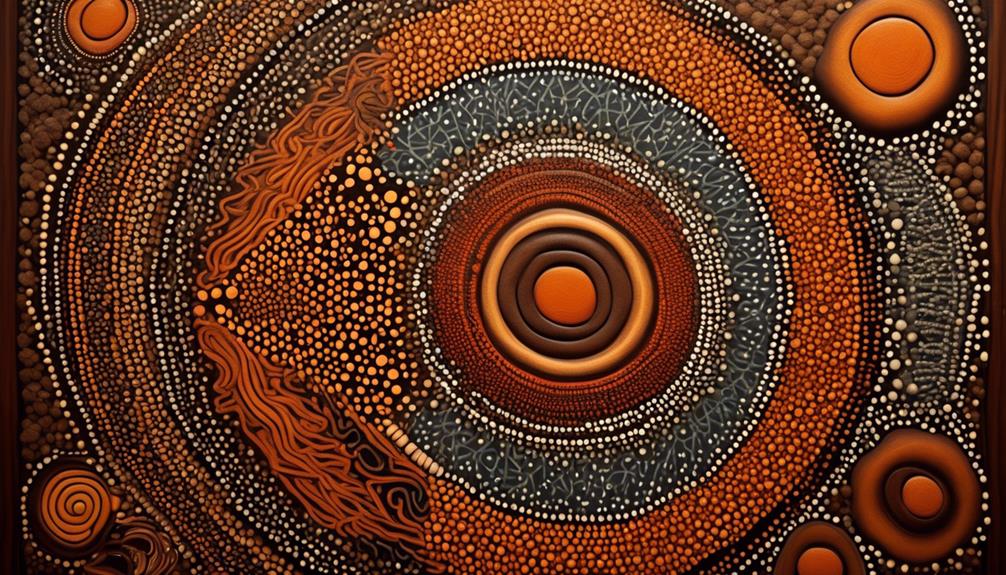
Over the centuries, Indigenous Australians have developed a rich and diverse tradition of art and music that reflects our deep connection to the land and our cultural heritage. Indigenous storytelling and dance are integral parts of our artistic expression, serving as powerful vehicles for passing down knowledge, traditions, and spiritual beliefs from one generation to another. These stories and dances encapsulate our intimate relationship with the land, animals, and the cosmos, embodying our collective wisdom and identity.
Traditional instruments such as the didgeridoo, clapsticks, and bullroarer aren't just musical tools but bearers of profound cultural significance, carrying the essence of our ancestral knowledge and spiritual connection to the land.
Moreover, the concept of songlines holds immense cultural importance for us. These intricate oral maps, woven into songs, describe the landscape, sacred sites, and ancestral stories, serving as a wayfinding tool and preserving our profound connection to the land. It's through songlines that we maintain our cultural memory and navigate the vastness of our ancestral territories.
In our art and music, we find not just creative expressions but a living embodiment of our cultural resilience and resistance. They're the manifestations of our survival, adaptation, and celebration of our identity despite centuries of adversity. Through our art and music, we continue to assert our presence and assert the continuity of our rich cultural heritage.
Health Disparities and Initiatives
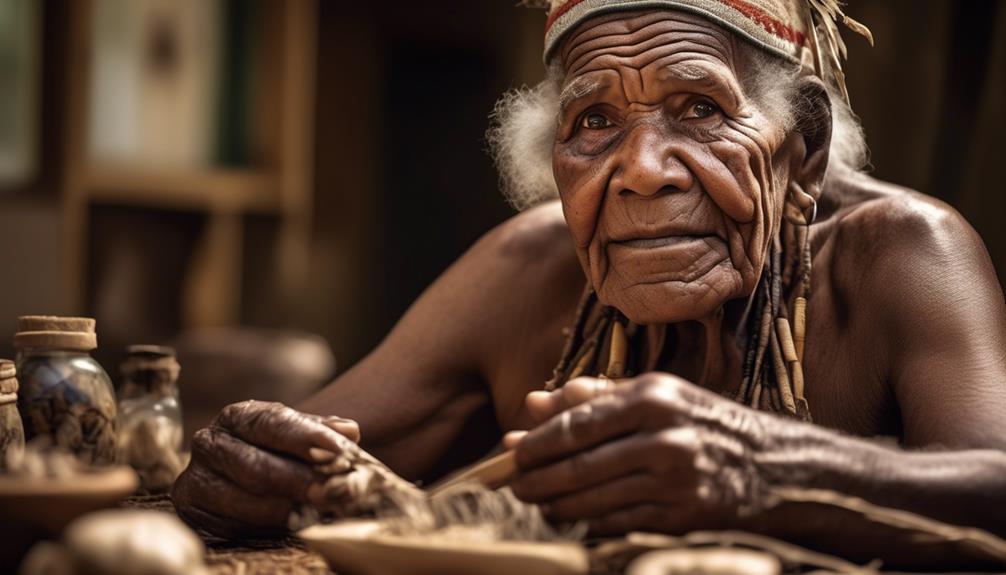
Having explored the rich tradition of art and music that reflects our deep connection to the land and cultural heritage, it's imperative to address the health disparities and initiatives within Indigenous Australian communities.
Our communities face significant health disparities, with higher rates of chronic diseases, mental health issues, and lower life expectancy compared to non-Indigenous Australians. However, there are ongoing community initiatives aimed at addressing these disparities and promoting holistic well-being.
- Challenges in Health Disparities: Our communities often experience barriers to accessing quality healthcare, including geographical remoteness, cultural insensitivity in healthcare services, and socioeconomic disadvantage. These challenges contribute to the disparities in health outcomes experienced by Indigenous Australians.
- Community-Led Initiatives: Many Indigenous communities are taking proactive steps to address these disparities through culturally sensitive healthcare services, community health education programs, and initiatives aimed at promoting healthy lifestyles. These community-led initiatives are crucial in bridging the gap in health outcomes and ensuring that our people receive the care and support they deserve.
- Integration of Traditional Healing and Modern Healthcare: Recognizing the importance of traditional healing practices, there's a growing movement to integrate traditional Indigenous healing methods with modern healthcare approaches. This integration acknowledges the holistic nature of health and the significance of cultural practices in promoting well-being.
In addressing these health disparities and promoting community-led initiatives, we're working towards a future where Indigenous Australians have equal access to quality healthcare and where our cultural approaches to healing are respected and integrated into the healthcare system.
Political Representation and Activism

When it comes to political representation, land rights activism, and cultural preservation efforts, Native Australians have been at the forefront of advocating for their rights and heritage.
We see their efforts in government representation, where Indigenous Australians have been working to ensure their voices are heard in decision-making processes.
Additionally, the ongoing activism for land rights and cultural preservation reflects the deep commitment to maintaining their traditions and connection to the land.
Government Representation
Native Australians actively engage in political representation and activism to advocate for their rights and interests within the government. This involvement is crucial for shaping policies that address the unique challenges faced by Indigenous communities.
Here are some ways in which Native Australians are participating in government representation and indigenous activism:
- Lobbying for legislative changes that recognize and protect Indigenous land rights
- Engaging in grassroots campaigns to raise awareness about issues affecting Indigenous communities
- Utilizing legal avenues to challenge discriminatory policies and seek redress for historical injustices
Through these efforts, Native Australians are working to ensure that their voices are heard in the political sphere and that the government upholds their rights and respects their cultural heritage.
Land Rights Activism
Engaging in grassroots campaigns and legal advocacy, we, as Native Australians, actively pursue land rights activism to secure recognition and protection of our ancestral lands.
Our efforts are rooted in the fundamental principle of indigenous sovereignty, asserting our right to govern our traditional territories.
Through alliances with non-Indigenous supporters and international solidarity networks, we strive to challenge discriminatory land policies and seek restitution for historical injustices.
By amplifying our voices in the political arena, we demand meaningful participation in decision-making processes that affect our lands.
Our activism isn't only about legal battles but also about fostering a deeper understanding of our spiritual and cultural connection to the land.
We're committed to creating a future where our rights as custodians of the land are respected and upheld.
Cultural Preservation Efforts
As custodians of our ancestral lands, we continue our advocacy for cultural preservation through active political representation and grassroots activism. Our efforts are centered around cultural revitalization and heritage preservation, aiming to ensure the survival and thriving of our traditional ways of life.
To achieve this, we engage in the following strategies:
- Political Engagement: We actively participate in local and national politics, advocating for policies that recognize and protect our cultural heritage.
- Community Empowerment: Through grassroots activism, we empower our communities to take ownership of cultural preservation efforts, fostering a sense of pride and responsibility for our traditions.
- Inter-Generational Education: We prioritize passing down traditional knowledge and practices to younger generations, ensuring the continuity of our cultural heritage for years to come.
Connection to the Land
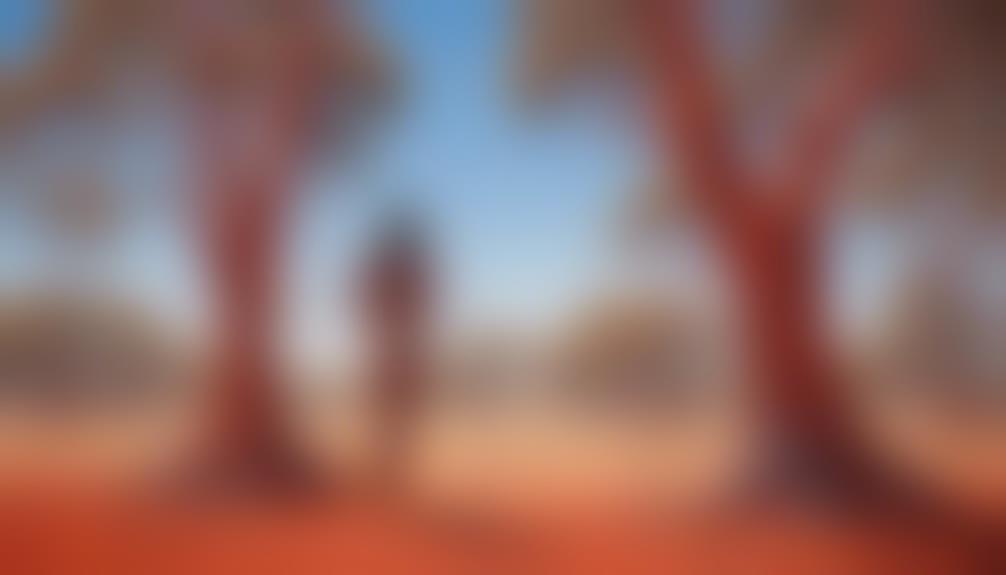
With a deep and enduring bond, indigenous Australians have maintained a profound connection to the land for countless generations. Our connection to the land is rooted in traditional ecological knowledge, which encompasses a deep understanding of the environment, sustainable practices, and environmental stewardship. This connection is central to our cultural identity and shapes our way of life, guiding our interactions with the natural world.
| Traditional Ecological Knowledge | Sustainable Practices | Environmental Stewardship |
|---|---|---|
| Indigenous Australians possess a wealth of traditional ecological knowledge, passed down through generations, which includes an intimate understanding of the land, its resources, and the delicate balance of ecosystems. | Sustainable practices such as controlled burning, hunting and gathering techniques, and land management strategies have been honed over millennia, ensuring the preservation of the land and its resources for future generations. | Environmental stewardship is inherent in indigenous Australian cultures, as we view ourselves as custodians of the land, with a responsibility to protect and nurture the environment for the well-being of all living beings. |
Our sustainable practices are deeply intertwined with our cultural and spiritual beliefs, reflecting a profound respect for the land and all its inhabitants. Through our connection to the land, we strive to maintain harmony and balance, fostering a sustainable coexistence with nature. It is our hope that by sharing our traditional ecological knowledge and sustainable practices, we can contribute to a broader movement of environmental stewardship and conservation, honoring the interconnectedness of all life on Earth.
Language and Linguistic Diversity
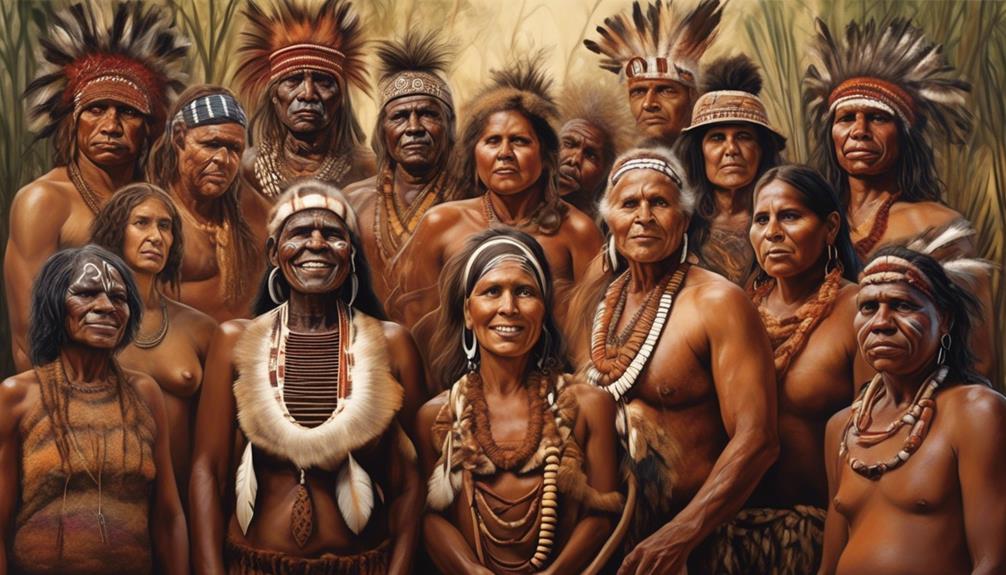
Our discussion on Native Australians can't be complete without acknowledging the rich tapestry of languages and linguistic diversity among Indigenous communities.
Language preservation efforts are vital in maintaining the cultural significance of these diverse languages, as they're deeply intertwined with the identity and heritage of Indigenous peoples.
The impact of language loss goes beyond communication; it shapes worldviews, knowledge systems, and social structures, highlighting the profound importance of linguistic diversity in Indigenous communities.
Language Preservation Efforts
Efforts to preserve the languages of Native Australians are crucial for maintaining their cultural heritage and promoting linguistic diversity. As we delve into the realm of language preservation, it's essential to understand the multifaceted strategies and community-driven initiatives that play a pivotal role in reviving and safeguarding Indigenous languages.
- Language Revitalization
Engaging community members in language revitalization programs fosters a sense of pride and belonging, empowering them to reclaim their linguistic identity.
- Preservation Strategies
Implementing comprehensive documentation techniques and developing educational resources are vital for preserving endangered languages and ensuring their survival.
- Intergenerational Transmission
Encouraging intergenerational transmission of language through family-based initiatives and educational curriculum integration reinforces the continuity of Indigenous languages within their communities.
Cultural Significance of Language
The preservation of Indigenous languages is integral to honoring the rich cultural heritage and promoting linguistic diversity within Native Australian communities. Language preservation isn't solely about words; it embodies cultural identity, traditions, and a profound connection to the land.
Each language reflects a distinctive way of understanding the world, encompassing unique knowledge systems and philosophies. When Indigenous languages thrive, linguistic diversity flourishes, contributing to the tapestry of human expression. Celebrating this linguistic diversity is essential for the preservation of heritage and the promotion of cultural resilience.
The revival and maintenance of Indigenous languages are acts of empowerment, reclaiming and reaffirming the value of traditional knowledge. By embracing and supporting the continued use of Indigenous languages, we actively participate in honoring and preserving the cultural legacy of Native Australians.
Impact on Identity
Embracing and preserving the diverse Indigenous languages of Native Australians is essential for cultivating a strong sense of cultural identity and fostering a deep connection to ancestral traditions. Our languages are repositories of our cultural heritage, carrying stories, knowledge, and spiritual beliefs that shape our collective identity. Their preservation is crucial in reclaiming and reaffirming our place in the world.
- Linguistic Diversity: Each Indigenous language reflects unique cultural perspectives and ways of understanding the world.
- *Cultural Revitalization*: Reviving and promoting our languages is an act of resistance against historical injustices and ongoing discrimination.
- *Empowerment*: Speaking our languages empowers us, contributing to our social justice and liberation movements.
- *Interconnectedness*: Our languages strengthen our bonds and connections with each other, fostering a sense of community and solidarity.
Celebrating Indigenous Heritage

Celebrating Indigenous heritage involves acknowledging the rich cultural traditions and history of Australia's First Nations peoples. It's a powerful way to honor and preserve the diverse practices and customs that have been passed down through generations. Through cultural heritage revival, we are able to celebrate traditions that have withstood the test of time, and continue to be integral to the identity and resilience of Indigenous communities.
| Traditions | Description | Significance |
|---|---|---|
| Dreamtime Stories | Oral histories and spiritual beliefs of creation and existence. | Connects people to the land and teaches moral lessons. |
| Didgeridoo | Traditional Aboriginal wind instrument. | Symbolizes cultural identity and is used in ceremonial practices. |
| Bush Tucker | Indigenous food gathering and preparation methods. | Sustains connection to the land and promotes environmental stewardship. |
| Aboriginal Art | Diverse forms of artistic expression including rock paintings and dot paintings. | Preserves cultural knowledge and serves as a means of storytelling. |
These traditions are not just relics of the past; they are living, breathing aspects of Indigenous culture. It's essential for us to recognize the value of these traditions and actively support their preservation and continuation. By participating in and promoting the celebration of Indigenous heritage, we can contribute to the empowerment and self-determination of First Nations peoples. It's a way of acknowledging the resilience and strength of Indigenous communities, and embracing the richness of Australia's cultural tapestry.
Frequently Asked Questions
What Are the Traditional Methods of Healing and Medicine Used by Native Australians?
Traditional healing methods often involve herbal remedies, cultural practices, and spiritual healing.
Traditional medicine often includes holistic healing techniques that focus on the interconnectedness of the mind, body, and spirit.
These methods have been passed down through generations and are deeply rooted in our cultural heritage.
They offer a holistic approach to health and well-being, addressing not only physical ailments but also emotional and spiritual needs.
How Do Native Australians Celebrate and Preserve Their Cultural Heritage Through Traditional Ceremonies and Festivals?
We celebrate and preserve our cultural heritage through traditional ceremonies and festivals. These events honor our ancestors, strengthen community bonds, and pass down our customs to future generations.
By participating in these rituals, we maintain our connection to the land, revitalize our language, and showcase our scientific contributions and technological innovations.
Through these celebrations, we continue to heal and thrive, embracing our Indigenous identity with pride and resilience.
What Are the Current Efforts to Revitalize and Preserve the Diverse Languages of Native Australian Tribes?
We are making concerted efforts to revitalize and preserve the diverse languages of native Australian tribes. These efforts are crucial in preserving cultural heritage and maintaining a strong connection to the land.
By prioritizing language revitalization, we honor and respect the traditions of our ancestors, ensuring that their voices and stories continue to be heard for generations to come.
These initiatives are vital in preserving the richness and diversity of our linguistic heritage.
How Do Native Australians Maintain a Connection to the Land and Natural Environment in Their Daily Lives?
Maintaining a deep connection to the land is essential for many indigenous communities worldwide.
In our case, Native Australians have sustained their ties to the natural environment through traditional practices and knowledge.
This connection fosters environmental sustainability and supports holistic wellness.
For example, our community's traditional healing methods often involve utilizing plants and natural resources from the land, highlighting the interconnectedness between our health and the environment.
What Are the Unique Contributions of Native Australians to the Fields of Science, Technology, and Innovation in Australian Society?
Innovation is a key driver of progress in society. Our contributions in science and technology have advanced various fields, shaping the world we live in.
Our unique perspectives and insights have fueled groundbreaking research and education initiatives, leading to valuable technological advancements.
Our culture has inspired new approaches and solutions, enriching the fabric of society.
We continue to make significant impacts, fostering innovation and progress in Australian society.
Conclusion
In conclusion, we've explored the rich and diverse culture of native Australians, learning about their origins, traditional practices, and the impact of colonization.
While some may argue that the Stolen Generations are in the past, it's important to recognize that the effects still impact indigenous communities today.
By celebrating and respecting their heritage, we can work towards a more inclusive and equitable society for all Australians.
Mary is a passionate writer who brings creativity and a fresh perspective to our team. Her words have the power to captivate and inspire, making her an essential contributor to our content. Mary’s commitment to storytelling and dedication to promoting Indigenous culture ensures that her work touches the hearts of our readers. We’re fortunate to have her as part of our team.
Aboriginal
How to Say Welcome in Aboriginal

As we delve into the rich tapestry of Aboriginal cultures, we often uncover the essential role that language plays in safeguarding tradition and identity. Just like Australia’s diverse terrains, each Aboriginal language holds its own distinct allure and significance.
Have you ever wondered how 'welcome' is expressed in Wiradjuri, Yolngu Matha, Pitjantjatjara, Noongar, or Arrernte? The nuances and intricacies of these languages offer a glimpse into the deep-rooted customs and values of the Aboriginal peoples.
Key Takeaways
- Language preservation is crucial for maintaining cultural identity and traditions among Aboriginal communities.
- Understanding the cultural context behind different Aboriginal languages is essential in expressing respect and honoring customs.
- Greetings and welcoming phrases in Aboriginal languages convey warmth, respect, and a sense of connection to land, ancestors, and community.
- The preservation of Indigenous languages ensures the passing down of traditions, stories, and knowledge to future generations.
Welcome in Wiradjuri Language
In Wiradjuri language, the traditional way to say 'welcome' is 'yindyamarra.' This word holds deep cultural significance within the Wiradjuri community, representing not only a greeting but also a sense of respect, kindness, and connection.
Language preservation is crucial in maintaining the cultural identity of the Wiradjuri people, as it serves as a vessel for passing down traditions, stories, and knowledge from one generation to the next. The preservation of the Wiradjuri language, including the word 'yindyamarra,' is a vital aspect of honoring and upholding the rich heritage and customs of this indigenous group.
Understanding the cultural significance of the word 'yindyamarra' goes beyond mere linguistic translation; it embodies the values and beliefs of the Wiradjuri people, emphasizing the importance of hospitality, inclusivity, and harmony within their community.
Greetings in Yolngu Matha
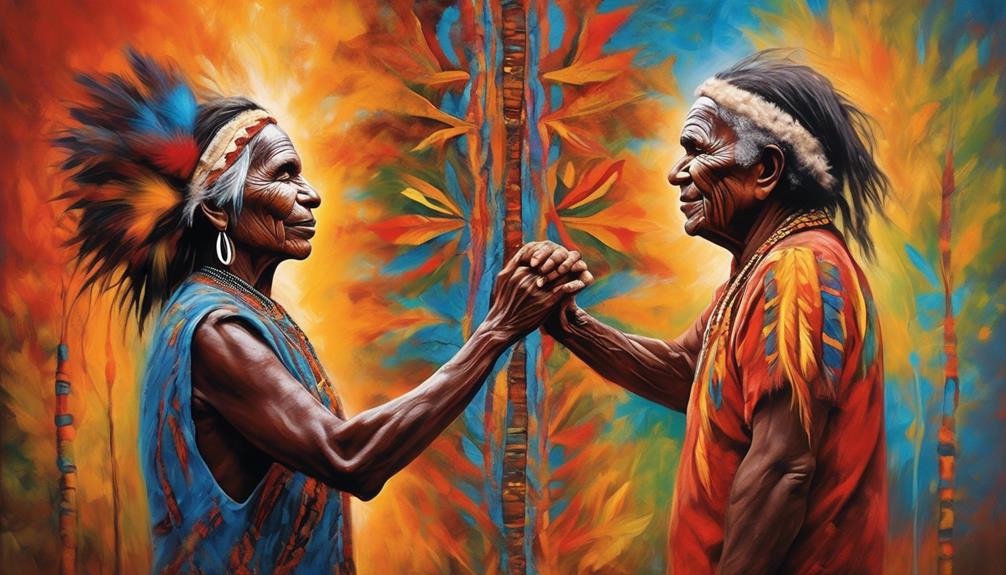
Greetings in Yolngu Matha encompass a rich and diverse array of expressions that reflect the deep cultural traditions and values of the Yolngu people. Yolngu Matha, the language of the Yolngu, has a profound cultural significance and varies across different Yolngu clans.
Here are some key aspects to consider:
- Connection to Country: Greetings often involve acknowledging the land and the ancestral connections, emphasizing the deep spiritual and cultural ties to the land.
- Respect and Reciprocity: Greetings in Yolngu Matha emphasize respect and reciprocity, reflecting the importance of harmonious relationships and mutual respect within the community.
- Ceremonial Context: Linguistic variations in greetings often depend on the ceremonial context, with specific greetings reserved for ceremonial occasions to honor tradition and spirituality.
- Kinship and Social Structure: Greetings reflect the complex kinship system of the Yolngu people, with variations in greetings based on the kinship relationship between the speakers.
- Teaching and Learning: Greetings in Yolngu Matha also serve as a means of teaching and learning, passing down cultural knowledge and traditions from one generation to the next.
Understanding the nuances of greetings in Yolngu Matha is essential for appreciating the depth of Yolngu culture and traditions.
Welcoming Phrases in Pitjantjatjara
Welcoming visitors in Pitjantjatjara involves using phrases that convey warmth and respect, reflecting the deep cultural traditions and values of the Pitjantjatjara people. The cultural significance of welcoming phrases in Pitjantjatjara can't be understated. These phrases not only serve as a way to greet visitors but also carry the weight of preserving the language and passing down traditions from one generation to the next.
In Indigenous communities, the importance of language preservation can't be overstated. It's through language that the history, customs, and spirituality of the Pitjantjatjara people are expressed and upheld.
The welcoming phrases in Pitjantjatjara are a testament to the profound connection between language and culture. As visitors are greeted with phrases such as 'Nganana nyuntu ngaranyi?' (Where are you from?) and 'Wai! Ngayuku nyangatja' (Yes! I'm good), they aren't only welcomed into the community but also given a glimpse into the rich linguistic and cultural heritage of the Pitjantjatjara people.
These phrases serve as a reminder of the resilience and strength of Indigenous languages and the significance of preserving them for future generations.
Saying Welcome in Noongar Language
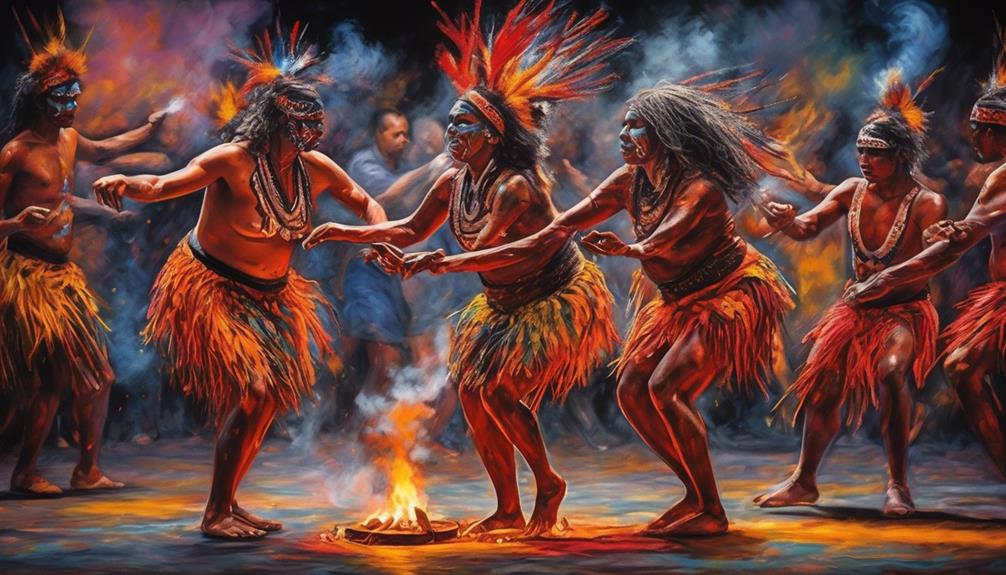
Curious to learn how to say welcome in the Noongar language?
The Noongar language, spoken by the Noongar people of Western Australia, holds deep cultural significance and plays a vital role in the preservation of their heritage.
Welcoming someone in Noongar goes beyond words; it embodies a connection to the land, ancestors, and community.
Here are five essential aspects to consider when learning to say welcome in the Noongar language:
- Cultural Significance: Understanding the cultural context behind the Noongar language is crucial in truly grasping the meaning of the word for welcome.
- Language Preservation: By learning and using the Noongar word for welcome, we contribute to the preservation of an ancient and beautiful language.
- Respect for Tradition: Embracing the Noongar language demonstrates respect for the traditions and customs of the Noongar people.
- Community Connection: Saying welcome in Noongar fosters a sense of belonging and kinship within the community.
- Acknowledgment of History: Using the Noongar language for welcome acknowledges and honors the history and resilience of the Noongar people.
How to Welcome in Arrernte Dialect
As we continue our exploration of welcoming in Indigenous languages, let's now turn our attention to the Arrernte dialect, which holds its own cultural significance and importance within the rich tapestry of Aboriginal languages. The Arrernte people, who reside in the central region of Australia, have a deep connection to their language and traditions. The cultural significance of greeting gestures in the Arrernte community cannot be overstated. Greetings are a way of showing respect, acknowledging the connection to the land, and honoring the ancestors.
To further emphasize the importance of language preservation in indigenous communities, let's take a look at the following table:
| Importance of Language Preservation | Cultural Significance of Greeting Gestures |
|---|---|
| Preserves heritage and traditions | Demonstrates respect and connection |
| Strengthens community identity | Honors the ancestors and their wisdom |
Preserving the Arrernte language is crucial for maintaining the unique cultural identity and ensuring that the traditions and knowledge of the Arrernte people are passed down to future generations. By understanding the cultural significance of greeting gestures and the importance of language preservation, we can honor and respect the diversity of Indigenous languages and traditions.
Frequently Asked Questions
What Are Some Common Cultural Practices or Customs Associated With Welcoming in Aboriginal Communities?
Common greetings in Aboriginal communities often involve warm embraces, handshakes, and the exchange of gifts.
Traditional dances and music are integral parts of cultural ceremonies and are used to welcome visitors and community members.
These practices are steeped in tradition and hold deep cultural significance.
Understanding and respecting these customs is essential for building positive relationships with Aboriginal communities.
Are There Any Specific Gestures or Body Language That Should Be Used When Saying Welcome in Aboriginal Languages?
When saying welcome in Aboriginal languages, gestures and body language play a significant role. Various Aboriginal communities have specific customs and cultural practices associated with welcoming, which may include handshakes, hugs, or other traditional gestures.
It's important to be attentive and respectful of these customs when greeting someone in an Aboriginal language. Understanding and incorporating these gestures can demonstrate cultural sensitivity and a genuine desire to connect with the community.
Are There Any Taboos or Cultural Sensitivities to Be Aware of When Welcoming Someone in Aboriginal Culture?
When it comes to welcoming someone in Aboriginal culture, it's crucial to be mindful of taboos and cultural sensitivities. Understanding the etiquette and hospitality practices is key to showing respect.
We should be aware of potential taboos and strive to honor them. Being culturally sensitive means recognizing and respecting the traditions and customs of Indigenous communities, ensuring our gestures of welcome are received with understanding and appreciation.
How Do Different Aboriginal Communities Express Welcome in a Non-Verbal Way, Such as Through Art or Traditional Symbols?
Artistic expressions and traditional symbols play a significant role in non-verbal communication and welcoming in various Aboriginal communities.
Different cultural practices, such as dance, song, and traditional art forms, are used to express hospitality and make visitors feel welcome.
These non-verbal gestures are deeply rooted in the rich cultural heritage of Aboriginal peoples and hold great significance in conveying warmth and acceptance.
What Are Some Traditional Foods or Drinks That Are Often Offered as a Sign of Welcome in Aboriginal Communities?
Traditional hospitality in Indigenous communities often involves offering specific foods and drinks as a sign of welcome. These offerings hold cultural significance and are an integral part of welcoming ceremonies.
Indigenous cuisine varies across different communities, with each having its own traditional foods and drinks that are used to express hospitality. Many of these offerings are deeply rooted in the history and traditions of the specific community.
Conclusion
In exploring the various ways to say 'welcome' in different Aboriginal languages, we're reminded of the rich and diverse cultural heritage of Australia's First Nations peoples. Each language holds its own unique significance and beauty, reflecting the deep connection to country and community.
As we continue to learn and embrace Indigenous languages, we also honor and respect the traditions and knowledge passed down through generations. Let's open our hearts to the richness of these languages and the wisdom they hold.
Embrace the beauty of diversity.
Mary is a passionate writer who brings creativity and a fresh perspective to our team. Her words have the power to captivate and inspire, making her an essential contributor to our content. Mary’s commitment to storytelling and dedication to promoting Indigenous culture ensures that her work touches the hearts of our readers. We’re fortunate to have her as part of our team.
-

 Culture2 weeks ago
Culture2 weeks agoUnderstanding Aboriginal Totem Significance
-

 Torres Strait Islanders3 months ago
Torres Strait Islanders3 months agoSacred Healing: Discovering Indigenous Health Secrets
-

 Torres Strait Islanders3 months ago
Torres Strait Islanders3 months agoJourney to Wellness: Indigenous Health Product Guide
-

 Torres Strait Islanders14 mins ago
Torres Strait Islanders14 mins agoCultural Vitality: Indigenous Health Tips
-

 Torres Strait Islanders3 months ago
Torres Strait Islanders3 months agoEmbrace Indigenous Wisdom: Top Well-Being Products
-

 Torres Strait Islanders3 months ago
Torres Strait Islanders3 months agoHolistic Health: Indigenous Wellness Explored
-

 Torres Strait Islanders3 months ago
Torres Strait Islanders3 months agoNature’s Wisdom: Indigenous Well-Being Remedies
-

 Torres Strait Islanders3 months ago
Torres Strait Islanders3 months agoIndigenous Health Products Guide for Wellness

















